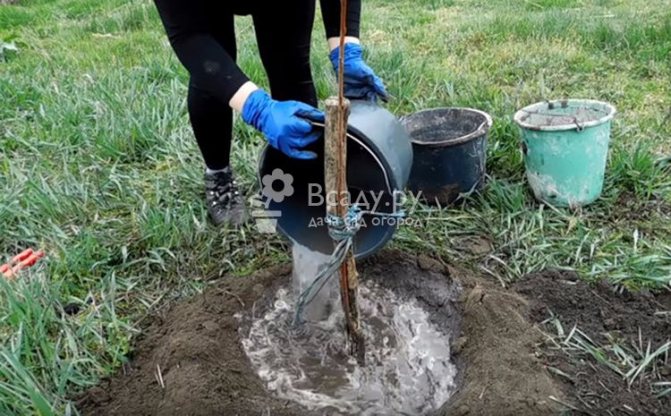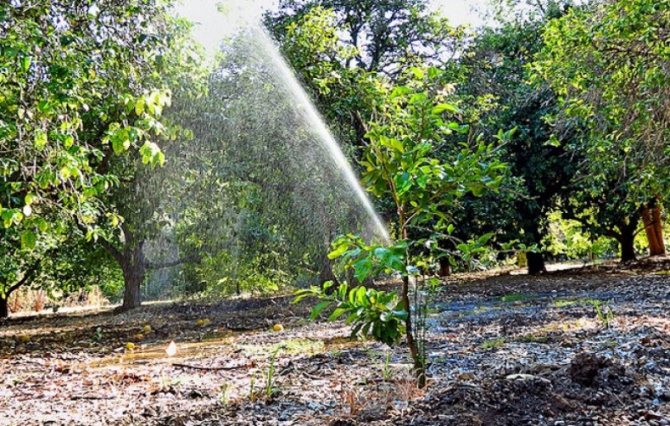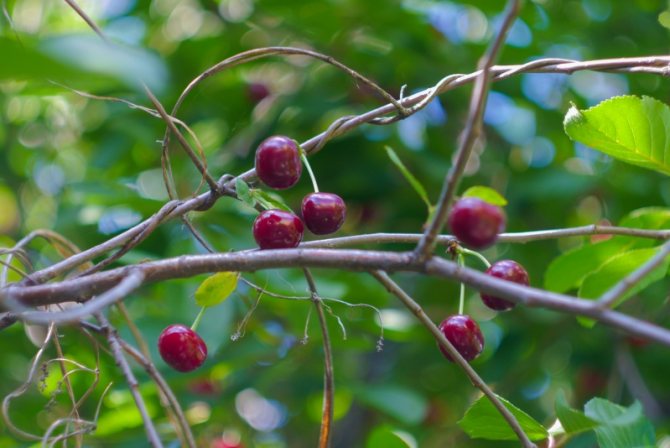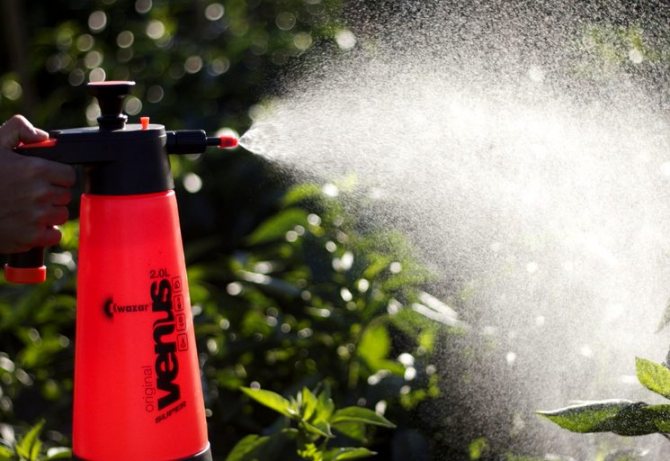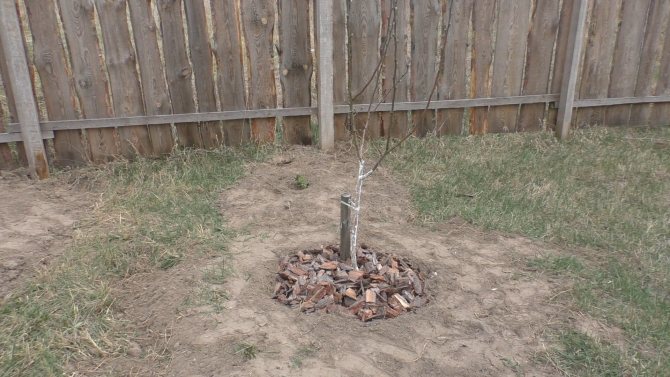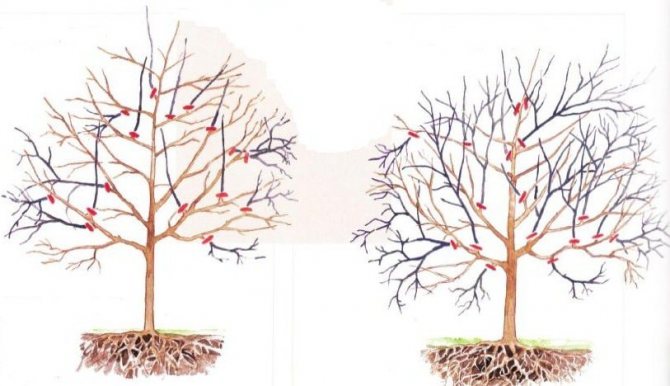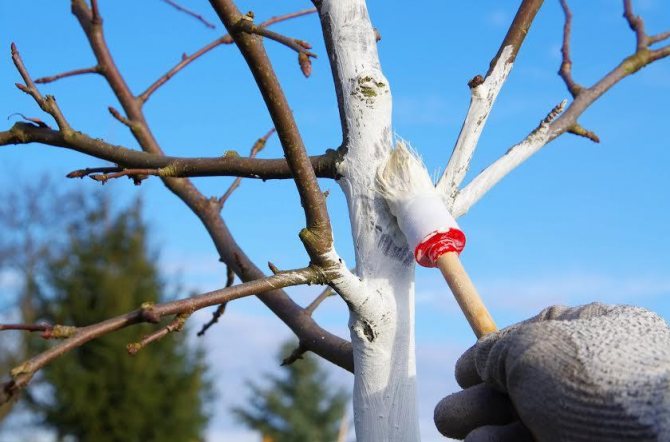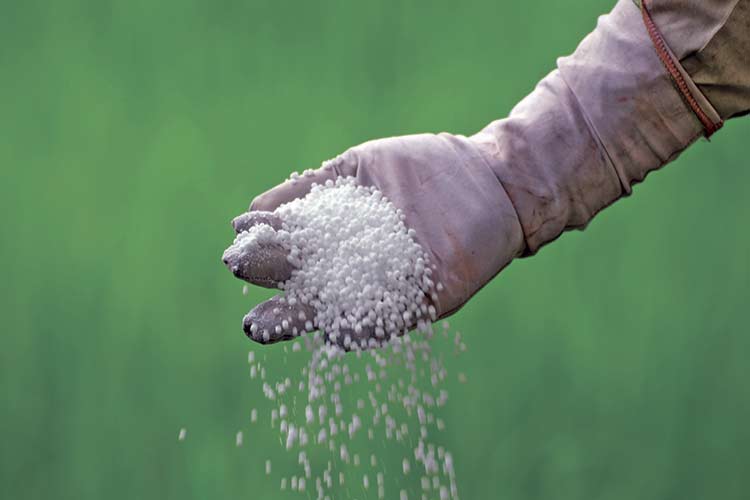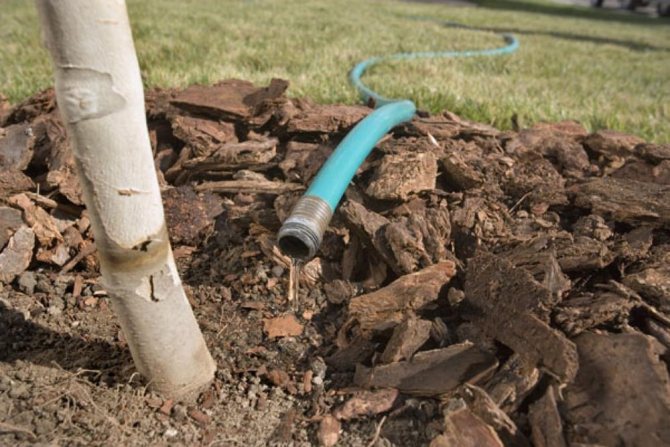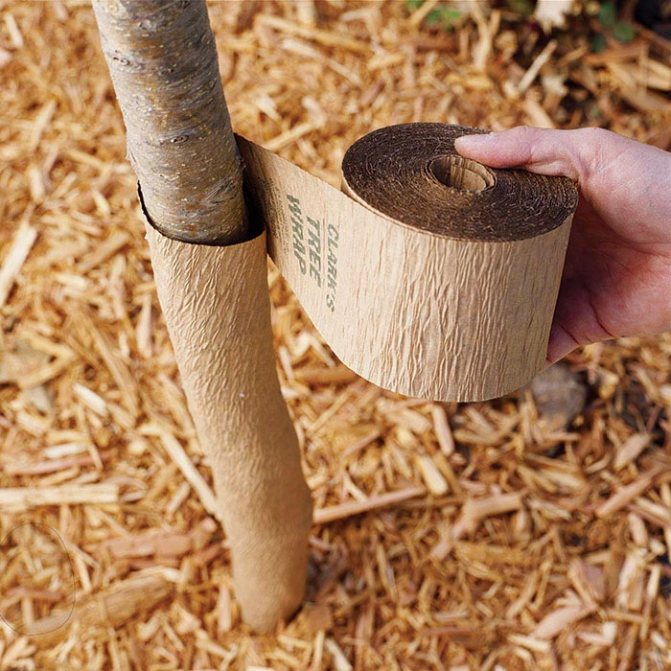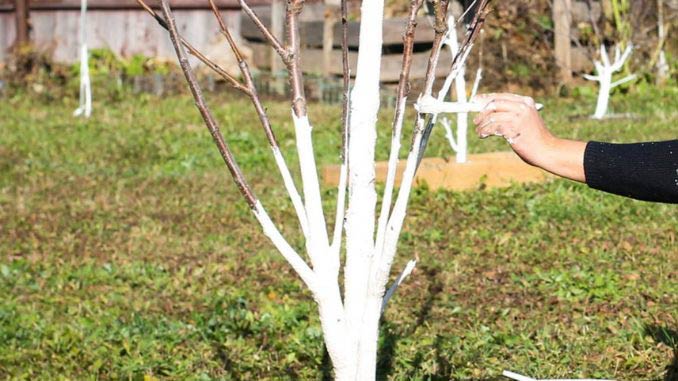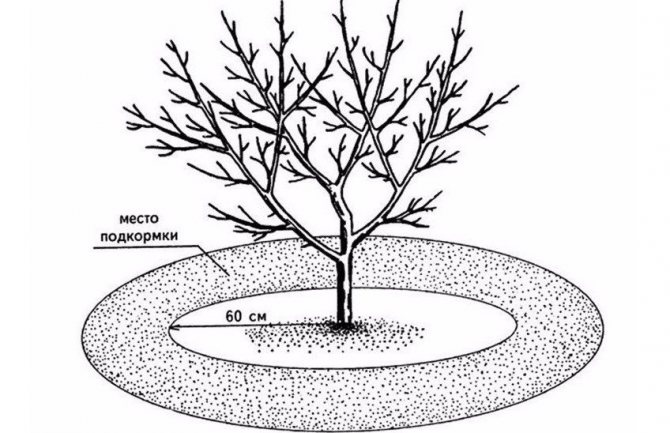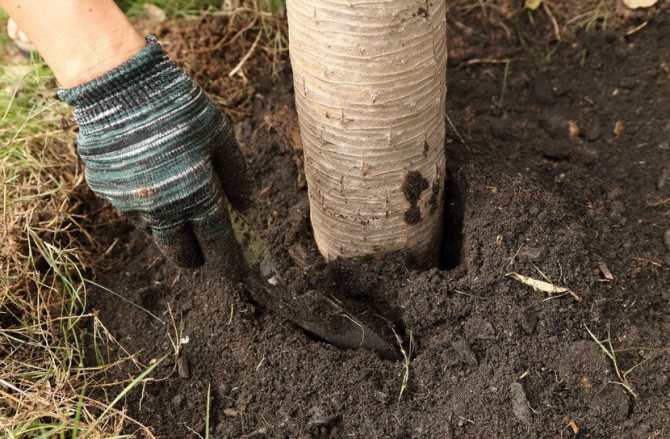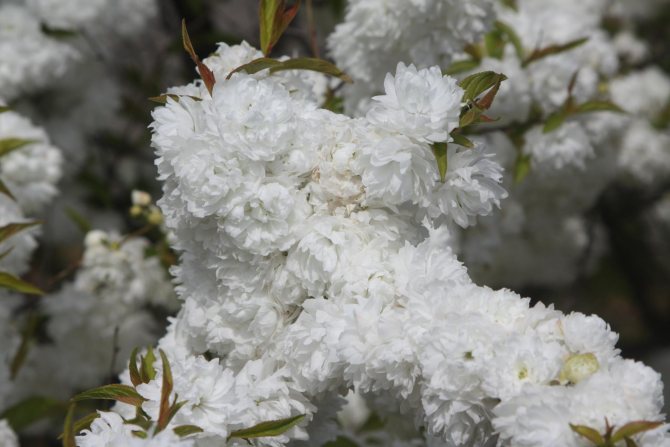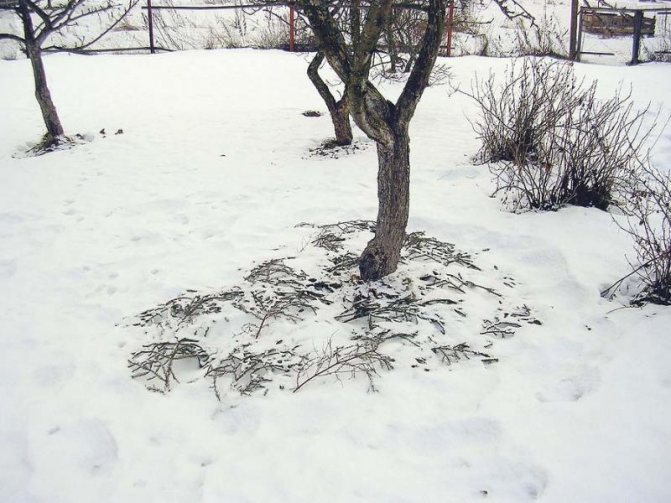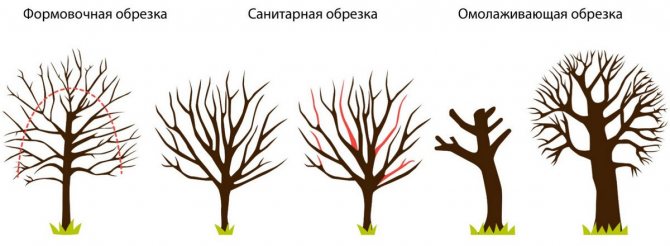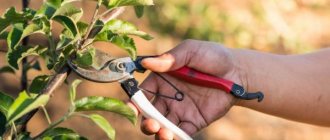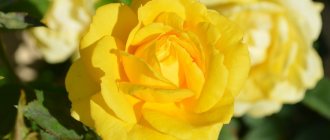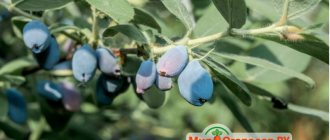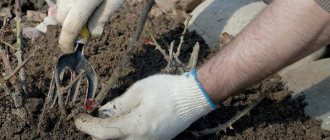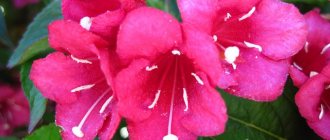What does complete wood care include?
Cherry tree maintenance is easy, even for novice gardeners. The main activities that need to be carried out annually in the garden where cherries and cherries grow are regular and moderately abundant watering of trees, their pruning and protection from diseases and pests, as well as removing weeds and introducing nutrients into the soil.
To achieve good fertility indicators, you need to know about the intricacies of care that is required for old and young plants, as well as about which months it is better to carry out certain activities.
Watering
Cherry trees are especially in need of regular watering in the first years after planting in the country. It is believed that in one season the plant should be watered, on average, 12 times. In this case, one should be guided by weather conditions and, depending on them, increase or decrease the frequency of irrigation.
After the calendar year has passed, the first watering should be done after the tree has bloomed, the second - at the time of pouring the berries.
The amount of moisture should be such that the soil is moistened to a depth of about 40 centimeters. Watering each tree requires about 3 to 6 buckets of water. To determine exactly how many times you need to water the plants, you have to take into account the amount of natural precipitation.
In autumn, after the leaves fall off, winter watering is carried out, during which the soil is spilled to a depth of 80 centimeters. Thanks to this moisture, the root system prepares for a successful wintering, and the soil does not freeze as quickly as dry.
Top dressing
To get a good harvest from a cherry tree, it must be fed regularly. Like other green dwellers in the garden, these plants need mineral and organic fertilizers.
Fertilization work begins in early spring, even before the flowers bloom on the tree. Urea or calcium nitrate is used as a top dressing. 60 grams of urea or 2 tablespoons of saltpeter are scattered over the entire surface of the trunk circle, then the soil is loosened. Such procedures are correct and favorable for growth and flowering.
When flowers appear, it is time to apply nitrogen and organic fertilizers, for example, bird droppings or cow dung. After flowering, the cherries can be sprayed with urea. To do this, 40 grams are diluted in 10 liters of water. Spraying like this helps maintain ovaries and improves tree nutrition.
Pruning
Pruning helps to intensify the growth of the cherry. The first time this procedure is carried out after swollen buds appear on the tree. If you miss this moment, it is better to cancel pruning altogether so as not to injure the plant. In the spring, first of all, the removal of frozen shoots is performed. After that, the slices should be processed.
Shoots less than 40 centimeters long do not need pruning. To prevent the crown from being too dense, it is enough to eliminate competing branches, as well as get rid of the shoots directed vertically. Crown pruning can be done during the summer months after picking the berries.
Pest control
Cherries, like most other members of the Pink family, are susceptible to many diseases.Most often, the tree is affected by fungal and bacterial diseases. Therefore, care involves the regular use of insecticidal and fungicidal preparations.
The basic rules for the prevention of cherry diseases are:
- whitewashing of trunks in the spring;
- several treatments to protect against disease during the season;
- compliance with sanitary standards.
Features of autumn feeding by region
The general principles apply to all regions. In a specific area, only the timing of the work differs. Also, adjustments are made by the specific characteristics of the soil - fertility and acidity.
In the Moscow region, poor sod-podzolic or podzolic species, loams prevail. The exception is the south of the region, where the land is fertile. For stable growth and fruiting, autumn fertilizing of cherries is required. The mixture is brought in in the second decade of September, if the autumn is warm - in early October. As a top dressing, purchased mineral mixtures are usually used here.
The middle lane, the Ural region - places where different types of soils are found, but all of them are not considered highly fertile. The optimal time for feeding is the first days of September, since the first frosts are already possible in October.
The climatic conditions of Siberia make it possible to grow only a few varieties of cherries. Usually these are early varieties and dwarf trees with increased frost resistance. Their features are the rapid completion of fruiting and the early period of "hibernation". They start feeding cherries in Siberia in August, and finish all work by the end of summer.
Seasonal nuances
Cherry trees must be cared for from the moment they are planted. At the same time, the nature of work changes during the season. Each period has its own subtleties.
Spring
Cherry care activities carried out in the spring help to obtain a rich harvest. During this period, trees are pruned, getting rid of:
- dried or frozen branches;
- too long shoots;
- parts damaged by pests and diseases.
In March, cherry trunks must be whitened, and the wounds on the bark must be treated with copper sulfate. This creates protection against parasites and bark damage.
In the near-trunk circle, dry grass should be removed, soil should be dug so that the root system receives oxygen. And finally, fertilization is a must-have item for spring care.
Summer
The peculiarities of summer care are associated with the fact that berries ripen at this time, gardeners harvest. Trees of early varieties bear fruit in June, other representatives of the species delight in harvest in July. In the same month and in August, the time of the highest activity of the sun comes. Therefore, plants have an increased need for moisture. They need to be irrigated regularly.
In addition, to prevent drying out of the soil, gardeners resort to mulching. This prevents moisture evaporation and also prevents infestation by various diseases and pests.
Autumn
Autumn is the time when cherries need to be prepared for wintering. Caring for her consists in pruning and feeding, disease prevention.
You can prune before the onset of the first frost. But only after the tree enters a dormant period. It aims to remove dry or diseased shoots. All cuts, cracks and wounds should be treated. The soil in the trunk circle must be cleaned and loosened. During these events, you can enrich it with potash and phosphorus fertilizers. To protect against rodents, the trunks can be whitewashed.
The importance of autumn care
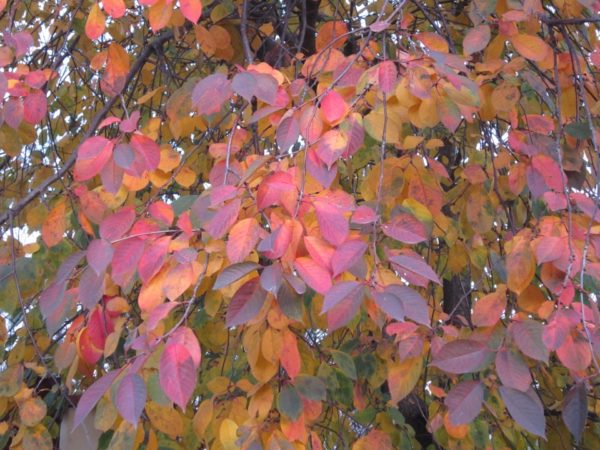
By the end of the growing season, the growth of cherry branches stops. The tree enters a dormant stage and prepares for the coming spring. At this moment, the buds are laid and the branches and trunk are lignified. In autumn, cherries need minerals and water-charging watering. This makes it possible to stock up on nutrients so that in the spring you can come out of the dormant stage without stress.
In winter, there is a great danger of fungal diseases affecting the cherry tree. Their spores fall on the plant in the fall, and with the onset of warm weather they begin to multiply rapidly. Therefore, it is important to treat the peri-stem circle and the plant itself with fungicides for diseases in time.
The risk of pest infestation, which becomes especially numerous by autumn, cannot be ignored. Insects are able to move from a nearby garden and lay eggs for reproduction. Therefore, measures to prepare cherries for winter include examining the tree and spraying with insecticides.
In winter, cherries are threatened by rodents, squally winds, frost and precipitation that can damage the crown. This impedes the growth of shoots and prevents active sap flow. Therefore, the yield of damaged cherries is significantly reduced. To prevent branch breakage, the tree is covered before winter.
Care features
The nuances of proper cherry care take into account not only the condition of the tree and weather conditions in a particular region, but also the age of the plant.
For young seedlings
In the first year after planting, seedlings need careful watering. During the hotter months, each cherry needs 5-6 buckets of water. In addition, plants need protection from pests. Their bark is very thin; it cannot serve as a reliable protection against harmful insects.
For prevention purposes, in spring and summer, cherries should be sprayed with Bordeaux liquid or copper sulfate.
Fruiting cherry
In order to get rich harvests of berries from a fruiting tree, during the period of their formation, you must adhere to the following care tips:
- in a rainy spring, spray the cherries with a solution of water and honey - this will help attract insects to the garden area;
- in a drought, it is necessary to provide the cherry with a large amount of moisture;
- monitor the acidity of the soil to preserve the ovaries;
- after the end of the harvest, at the end of September, water the cherries abundantly, pouring 8-10 buckets of water into the trunk circle;
- in the fall, potash and phosphorus fertilizers should be applied;
- it is necessary to monitor the condition of the crown, thinning it from time to time;
- during the growing season to prevent the reproduction of pests.
When picking a crop from a fruiting cherry, it is worth remembering that the plucked berries do not ripen and remain sour and tasteless.
Old tree
Caring for old cherry trees includes cleaning, burning off dead bark, whitewashing and pruning. The age of the cherry indicates the appearance of coppice basal shoots. The more intensively they grow, the lower the viability of the plant becomes. This growth must be removed regularly. Sick, dry and damaged branches should also be disposed of.
Cherry propagation - the main ways
Cherry reproduces successfully in all possible ways, both vegetative and seed. Of course, during seed propagation, not all of its varieties inherit varietal characteristics, but this does not mean that the method is less popular. It is actively used for growing felt cherries, which successfully repeat the characteristics of mother plants, for growing rootstocks or trees that are highly resistant to difficult local conditions.
Cherry propagation by cuttings in spring
Cuttings are taken as green - in the summer, and lignified - after the fall of leaves and before the awakening of the buds.
Cherry propagation by lignified cuttings
Cuttings are harvested in late autumn or winter. They are taken only from healthy trees. Diameter - not less than 4 mm. They are kept in the refrigerator until spring. How to root?
- It is important that the roots begin to develop earlier than the buds. Otherwise, the stalk will die. Therefore, you need to place the cutting itself in a cool place, and the roots in a warm place.
- Update the cut at the bottom of the cutting, make vertical cuts along the bark, 3-4 cm each.
- The lower buds, if there are too many of them on the handle, remove.
- Treat the place of appearance of future roots with a stimulant (Kornevin, Epin) according to the instructions.
- Plant the cuttings in boxes, with the expectation that for each cutting there should be 10-15 cm of area.
- Soil - from sawdust and earth in a ratio of 3 to 1. The mixture should be loose, breathable. You can pre-plant each black in separate packages, and then in a common box, so that later it would be easier to transplant them.
- The cuttings are placed vertically, so that the slices are hidden by 1 cm.
- The box itself is placed in a cool, bright room.
- Different devices are used to heat the soil, the simplest is ordinary incandescent lamps located in a container with holes, on which the box is placed.
- After 10 days, roots will start to appear.
- Transplanting young plants in autumn.
Cherry propagation by green cuttings
Cuttings are harvested until mid-summer. Choose strong green branches on the south side. Cut obliquely. The cuttings are soaked in water, the tops with the leaves are cut off. Cuttings with several leaves remain. They are planted in a box filled with a breathable mixture. In winter, the boxes are buried in, in the spring the rooted cuttings are transplanted to a permanent place. Planting rules are the same as for young seedlings.
Plants obtained from green cuttings begin to bear fruit one year after planting in a permanent place.
Cherry propagation by growth
Growing cherries from root shoots is one of the easiest ways. In early spring, the root cutting is separated from the mother tree, and added dropwise at an angle of 45 degrees. As soon as fresh shoots appear, it is transplanted to a permanent place.
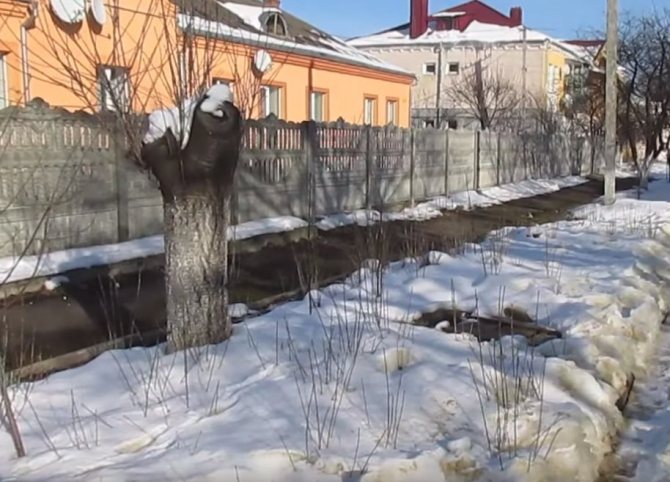

Cherry root growth around the tree at the age of 25
Cherry vegetative propagation: grafting
One of the best methods for rare, large-fruited and late varieties. When grown from seeds, such varieties do not inherit varietal characteristics; it takes too long to wait for yields from one-year-old seedlings. Cherries are grafted by methods of budding, copulation, in the split and behind the bark. Wild cherries, sweet cherries, plums are used as a stock. The best rootstocks for cherries are considered wild bird cherry antipka, clone rootstocks Rubin, OVP-2, P-7, VTs-13 and compact VSL-2.
Growing cherries from pits
Growing cherries from the seed allows you to get strong plants adapted to the conditions of the region. This method is good for felted cherries and certain varieties. Seeds, as in all stone fruit crops, undergoing a long period of dormancy, require stratification. The best way: free the seeds from fresh cherries from the pulp, let them dry, mix with sand, put in the common compartment of the refrigerator for 5 months. In spring (April-March), sow in pots. As soon as the soil warms up, plant young seedlings in a permanent place. If conditions permit, seeds can be stratified in natural conditions: in this case, they are sown in the fall.
How to prepare a tree for winter
Cherry belongs to frost-resistant plants. Nevertheless, protection from frost, in most regions, is necessary for it. It is necessary to prepare for winter in advance. To do this, in the fall, the ground around the trunk can be covered with straw or sawdust. This will protect the root system from freezing. The pre-winter soil spill serves the same purpose. After that, the soil is mulched with peat or manure.
Experienced gardeners recommend, on the eve of winter cold, "wrap" the trunks of young cherries with pine spruce branches.
The cuts and wounds remaining after pruning must be treated with garden varnish. Woven materials can be used to protect the trunks. This prevents rodents and other animals from damaging the bark. Knowledge of the basic rules of care and their timely application will allow you to enjoy the pinkish caps of flowering cherries in your own garden in spring and the harvest of fragrant berries in summer.
Pruning and removing overgrowth
Cherry pruning is a moot point.It is believed that cherry trees are too sensitive to this, it is better to cut them only at a young age. There is another thing: supposedly it is not worth cutting the tree if it is covered with flowers of high quality. However, thinning cherries is necessary if there is a desire to receive not only beautiful flowering, but also the maximum yield. On the other hand, for a beginner, the pruning procedure itself, especially when it comes to an old tree, is rather complicated. Today, there are even field specialists who, for a fee, will carry out competent pruning of adult cherries.
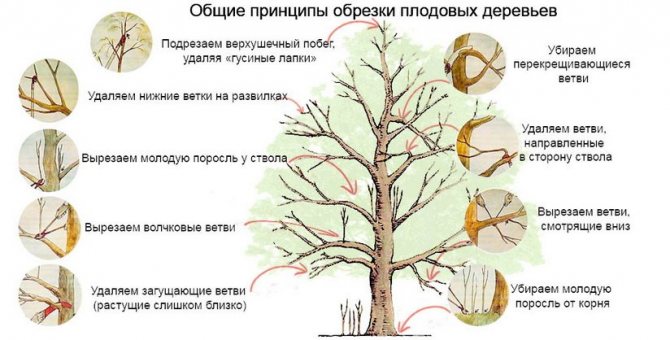

The main rules for pruning fruit crops
The pruning rules depend on the type of cherry: bushy or tree-like. The first one bears fruit mainly on annual growths, in tree-like fruits, in addition to annual growths, fruits are formed on bouquet branches. Flower buds are located on annual branches from the outside of the crown. Cherry begins to bear fruit early, on annual branches, which are a continuation of the skeletal ones. With the age of the tree, by the age of 15–20 years, the annual increments weaken greatly, the skeletal branches become bare, and the yield decreases. On annual growths longer than 40-50 cm, flower and growth buds are formed, on shorter growths, flower buds are formed only on the sides, and growth buds - on top. Such branches remain bare after harvest.
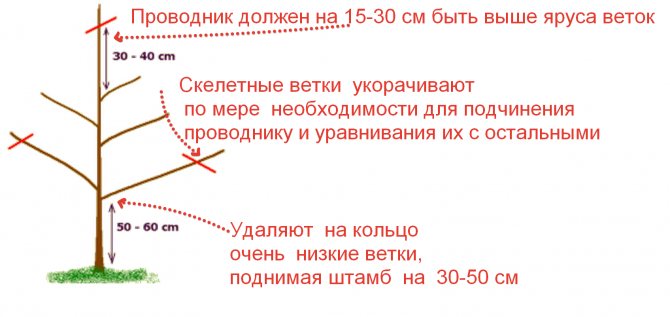

Formative cherry pruning: basic rules
How to thin out cherries in spring
Highlights for pruning bush or tree cherries:
- Before pruning, you should understand how the annual shoot of the bush works. It has both flower and growth buds, collected 2-3 per node. The older the bush, the fewer growth buds. On a short annual growth - 20 cm - growth buds are located only at the top.
- In trees, flower buds are located differently: on bouquet branches that bear fruit and live for several years.
- The optimal length of annual growth for bush cherries is 30–40 cm.
- If the growth is longer than 50 cm, there is an overfeeding with nitrogenous fertilizers or freezing of the buds. Growths that are too long mean fewer flower buds.
- The branches at the bottom of the crown are cut to those branches that are directed upward.
- If the growth length is less than 20 cm, an even more intensive rejuvenating pruning is required. Remove all unhealthy branches, those that do not have branches and growths.
- If pruning is primary, be sure to do moderate pruning so that the tree does not immediately lose too much mass at a time.
- Do not leave hemp when pruning.


Rules for trimming for a ring and for translation
How to get rid of cherry overgrowth on the site
Cherry - depending on the variety and species, of course - forms quite a few side shoots. This growth is regularly removed: for the purpose of reproduction, and so that it does not take away the vitality from the main tree. This is done simply - the shoots are cut at the root. It is important to do this so that a new plant does not start growing from a new point of growth after a few weeks. And this is more than true if the shoots are simply torn off or cut off above ground level.
To get rid of the overgrowth efficiently, each shoot is carefully buried in, reaching the large roots of the main tree. Shoots are cut from the root, the wound is treated with garden varnish.


Cherry root shoots are removed from the point of growth of the main roots
There is an option to get rid of overgrowth with the help of a herbicide from weeds - Roundup, Pruner, Hurricane. Unnecessary shoots are treated like weeds. But not all gardeners enjoy the use of chemicals.
To avoid the spread of overgrowth on the site, the cherry root system is fenced off. They use linoleum, slate, old barrels of 200 liters (they are cut into rings), but the system of the vegetable garden should be thought out and prepared even before planting the seedling.
Cherry care in autumn - 5 most important rules
Adding an article to a new collection
Autumn cherry care comes down to following several important rules. We will talk about them in our article.
Cherry is a reliable, cold-resistant, drought-resistant crop, but this does not mean that it does not require maintenance. During the summer season, it is imperative to fight diseases and pests, water the tree in a drought, and feed it. Cherry also requires care in the autumn, for this next year it will give you a good harvest, will delight you with lush flowering and elegant foliage.
Autumn transplant
If the cherries need to be transplanted, then this is done in the fall, since in the spring the plant starts growing early.
Step-by-step execution of work:
- The stem is dug in a circle, stepping back from the trunk by 35 cm.
- The soil in the formed circle is watered abundantly.
- The main roots holding the plant are identified and filed down.
- Slices are cleaned with a knife.
Then they put strong poles under the freed root system and pull out the plant with their help. It is recommended to immediately transplant it into a previously prepared hole, the dimensions of which exceed the diameter of the earthen coma. In this case, the roots are carefully straightened so that they do not bend up. The pit is filled up, occasionally shaking the tree by the trunk to fill all the air voids.
An almost filled planting pit is well tamped, directing the force from the edge to the center. Then the remaining soil is poured and the transplanted plant is abundantly watered.
Rule 2. Water the trees well
It is possible to carry out water-charging cherry irrigation immediately after dug up and loosened the soil around the trunk. Such pre-treatment of the soil will allow moisture to penetrate deep into the soil, and, as you know, wet soil freezes much more slowly than dry.
But in order to wet the soil as deeply as possible, at least two buckets of water must be poured under each tree. In this case, it is advisable to use water several degrees warmer than the air temperature on the day of irrigation. In order to prevent irrigation water from spreading over the site, the zone of the near-trunk circle can be limited by a trench 10-12 cm deep.
Features of spring care in different regions
An important factor affecting the quality of the cherry harvest is the weather and climatic characteristics of the region. The presence of precipitation and strong winds, the temperature regime, the amount of sunlight - all this makes its own adjustments to the spring care of the cherry orchard.
Cherry care in spring in Siberia
Spring in Siberia is late and short. In March, there is still snow everywhere, the snow cover melts only after mid-April. During the winter, a lot of snow usually falls here, up to 1 meter, it melts slowly, which leads to damping out of the root collar. Therefore, in March, when the daytime air temperature begins to exceed 0 degrees, it is necessary to shake off most of the snow from the trees.


The high snow cover in Siberian gardens melts very slowly in spring, and so that stagnant melt water does not lead to the decay of the root collar, it is necessary to shake off most of the snow from tree trunks in early spring
To destroy the dense snow crust, I sprinkle the area around the stamp with a thin layer of ash. The dark surface attracts the sun's rays, and the snow begins to melt faster.
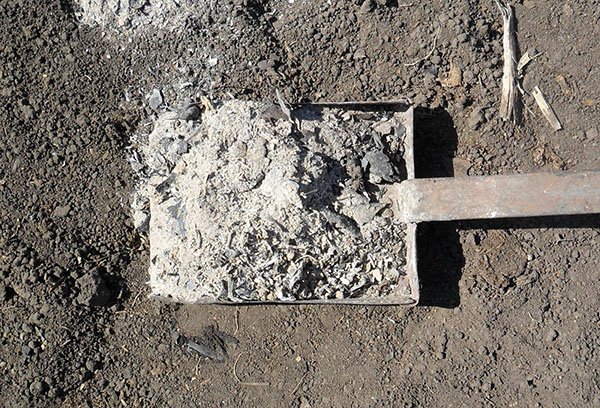

In order to speed up the melting of snow in the garden, the trunks can be sprinkled with wood ash.
The land in the north does not warm up for a long time, and the air temperature rises significantly during the daytime. As a result, a contrasting thermal regime is created for the root system and the aboveground part of cherries, which can lead to the death of young immature trees. Therefore, local gardeners prefer to plant cherries on mounds 40–50 cm high - elevated areas are cleared of snow faster, warming up better. As soon as the soil thaws, the first loosening is carried out.
Siberia is characterized by unstable weather in spring, with sharp cold snaps and even frosts. Return frosts are especially dangerous when buds and flowers appear.In order to postpone the flowering time, in winter they scoop up more snow to the trunk, and cover it with straw or sawdust on top. The ground will thaw more slowly, and cherry blossoms will begin to bloom a week later.
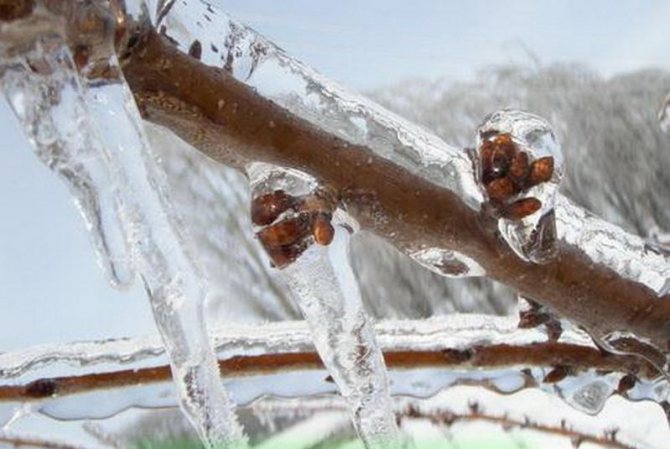

Spring Siberian frosts are especially dangerous for awakened trees with swollen buds
Fan watering of trees will also help mitigate the harm from spring cold snaps. This will increase the frost resistance of cherries by 50%, and the losses will be much less. Young plantings will be protected from frost stress by treatment with Epin's solution. The ampoule of the drug is diluted in 5 liters of water and the crown is sprayed before cooling and after the onset of frost. It will not be superfluous to shelter young animals during the return cold weather with light nonwoven materials.
In the spring months in Siberia, little precipitation falls, if there are rains, then short-term. Therefore, after the melt water has been absorbed and the top layer of the soil has dried, irrigation must be carried out so that moisture penetrates to the root layer to a depth of 40 cm.


For watering cherries, it is convenient to use a drip system, which ensures an even flow of moisture to the root system
Rule 3. Feed the cherries
It is advisable to combine fertilization in the autumn period with watering. So they will quickly get deep into the soil to the horse system. It's great if you manage to feed the cherries at the very beginning of autumn, because later the tree literally goes into hibernation and uses fertilizers only in early spring, which, in fact, is also not bad.
What to use as fall fertilizer? Anything. The main thing is that there is no nitrogen in the top dressing, which can activate growth processes and reduce the winter hardiness of the plant. If there is compost, you can use it (for trees from 1 to 7 years old - 1.5-2 kg per 1 square meter of the trunk circle, for trees over 7 years old - 2.5-3 kg), mineral fertilizers are also suitable. The ideal option is phosphorus plus potassium (for young trees - 2 tablespoons of superphosphate and 1 tablespoon of potassium chloride per 1 square meter, for fruit-bearing trees - 3 tablespoons of superphosphate and 1.5 tablespoons of potassium chloride ).
A rich harvest cannot be obtained without proper feeding
Autumn feeding of cherries after fruiting
After abundant fruiting, all fruit trees, including cherries, need replenishment of strength in order to successfully lay flower buds
(
= high harvest next year), as well as prepare for wintering.
So, cherries during this period require fertilizers containing an increased amount potassium and phosphorus.
Note! In no case in the fall, you can not feed with nitrogen fertilizers such as urea or ammonium nitrate.
- As potash feeding
make optimal use
potassium sulfate (potassium sulfate
), which is the most concentrated potash fertilizer.
- Concerning phosphorus
then your choice is
regular or double superphosphate.
- There are also complex mineral fertilizers such as potassium monophosphate (it costs more, but also more effective, because it acts instantly), or ready-made special "Autumn" (= phosphorus-potassium) fertilizers for the garden.


- For fans of natural products (organic fertilizers), the best potash fertilizer is wood ash, phosphoric - bone flour.
Important! Usually, all fruit trees in the fall are fed about the same, therefore, as an option, you can familiarize yourself with with this detailed material about the autumn feeding of the apple tree.
Concerning way feeding
, then since the root system of a sweet cherry (like any other fruit tree) lies deep enough, it is optimal to cook
liquid solutions
.
Under each tree, depending on its age, it is necessary to pour a certain amount of 10-liter buckets of phosphorus-potassium fertilizer solution:
- 2-3 year old tree - 1-2 buckets;
- 4-6 year olds - 2-3 buckets;
- 7-10 - 3-4 buckets;
- over 10 years old - 4-5 or more buckets.
Rules for autumn feeding of cherries:
- Before performing liquid fertilizing, the tree should be shed abundantly with plain water.
- You can either mix potassium sulfate and superphosphate in one bucket or feed separately.
- Liquid top dressing should be applied around the crown circumference.
Note! All stone fruit crops are taken from the soil a lot of calcium to build your bones, so it is highly advisable to periodically feed cherries with calcium fertilizers, for example, dolomite flour (it also deacidifies the soil). Moreover, you can make them at any time - both in autumn and spring.
However, if you want to use calcium nitrate, then it is recommended to apply it in early spring (since nitrogen fertilization).
Video: what and how to properly feed cherries (sweet cherries) after harvest
Foliar dressing for better ripening of shoots
If at the beginning of autumn you see that a young cherry planted this spring, shoots are still quite green, i.e. unripe and not lignified (and such shoots simply cannot overwinter and will necessarily freeze out), then to accelerate their ripening (in winter they should go brown) you need to make sure foliar top dressing (spray with a solution on the sheet) with phosphorus-potassium fertilizer (optimally - potassium monophosphate).
By the way! For ripening cherry shoots, it is also used summer chasing or pruning... In this case, the length of the young growth should not exceed 40-60 cm, everything else needs to be cut off.
Rule 4. Tidy up the garden
Preventive measures in the garden are mandatory, especially for cherries, which have a lot of pests and diseases. You should not be limited to one thing, it is better to do the maximum amount of work - to cut off sick, broken and damaged shoots and cover up the cuts with garden pitch; cover up or clean up all cracks in the bark, as well as wounds from which gum flowed during the season; remove foliage, fallen fruits and leaves (even if they are behind the trunk circle).
Cherries are processed immediately after the first frost. The best option is spraying with a 4-5% urea solution. Despite the fact that this nitrogen fertilizer, getting into the soil, it will not wake up trees, but will bring them considerable benefit, destroying wintering pests and pathogens.
How to whiten cherries in autumn
The purpose of the autumn whitewashing of any fruit trees (including cherries) is prevention of frost damage (sunburn), cracks on the bark, which are formed due to temperature changes (plus-minus, plus-minus) in the transitional winter-spring period (in February-March).
Note! Whitewashing in the spring (April-May) does not make any senseapart from the aesthetic.
It's another matter if you come to the dacha in late February or early March and whitewash. But is this possible if you are a city dweller?
Accordingly, it is necessary to whitewash old trees, and especially young ones. Moreover, to whitewash the trunks of young seedlings, weaker solutions should be used (if you use lime, then its concentration should be reduced by 2 times) so as not to burn the young bark. Or you can use special paints for whitewashing garden trees: buy the same water-based or water-dispersible paint, or acrylic paint. In any case, it is imperative to whitewash, since young seedlings have a very thin bark, which can be quite easily damaged in late winter or early spring from sunburn (it simply bursts due to temperature differences).
By the way! The site already has an article about when and how to whiten fruit trees in autumn (all trees are whitewashed in the same way).


By the way! There is a not unfounded opinion that very young seedlings with smooth bark it is better not to whitewash, but to wrap the barrel with white covering material (spunbond ribbons)... So you not only prevent sunburn, but also protect the seedling from rodents (more on this in the next paragraph).
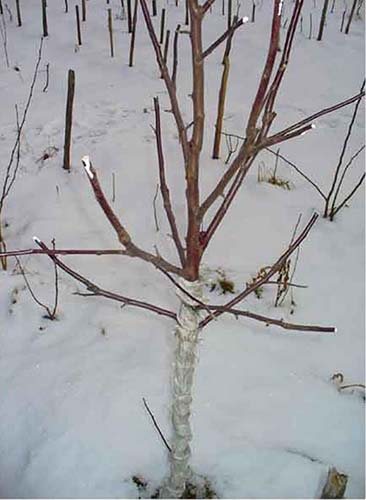

Rule 5. Insulate and whitewash the trunks
Everyone knows that cherry is a winter-hardy culture, but it is still worth saving from surprises. And there are different surprises: the climate in the middle lane is so changeable that even before the snow falls, frost can unexpectedly hit, and for young trees this almost always means that the tissues will freeze.
Therefore, the stems of 2-4-year-old cherries should be wrapped in burlap, newspapers, spruce branches or any other breathable material. It is advisable to wrap the base of the trunk with a plastic net, which will protect it from rodents.
The trunks of mature trees should be whitewashed. Whitewashing will not only protect the bark from the harmful effects of the scorching sun rays in winter, but also scare off rodents, especially if you add iron vitriol to it. The main thing is not to whitewash the trunks too early, otherwise the autumn rains will wash away all the whitewashing.
Whitewashing will protect cherries from the sun and rodents
Don't neglect these simple rules. After all, a few hours spent on autumn care will help cherry trees survive the winter with minimal losses.
Autumn care for a good harvest
Although cherries tolerate drought and low temperatures well, they still need care and quality preparation for the winter. In summer, the plant needs protection from diseases and pests. In a drought, the tree must be watered and must be fed with fertilizers. With proper care of cherries in autumn, the tree pleases with abundant flowering and gives a high yield.
Digging the soil
In autumn, the soil in the near-trunk circle must be dug to a depth of 15 cm. It is not necessary to dig deeper so as not to harm the roots of the plant. Finish the processing of the trunk circle by loosening the soil with a rake. The parts of the weed roots found during the digging must be removed.
Watering
Immediately after digging and loosening the soil, the cherry is watered abundantly. Due to the peculiar preparation before moistening, the water penetrates deep into the soil and does not freeze longer. In order for the watering to be of high quality and the water to penetrate to a great depth, at least two buckets are poured under each tree. In this case, the water should be used slightly warmer than the surrounding air on the day of watering. To reduce water consumption and prevent it from spreading over the site, the near-trunk circle is limited to a trench 10 cm deep.
Read also Zeolite for water purification
Top dressing
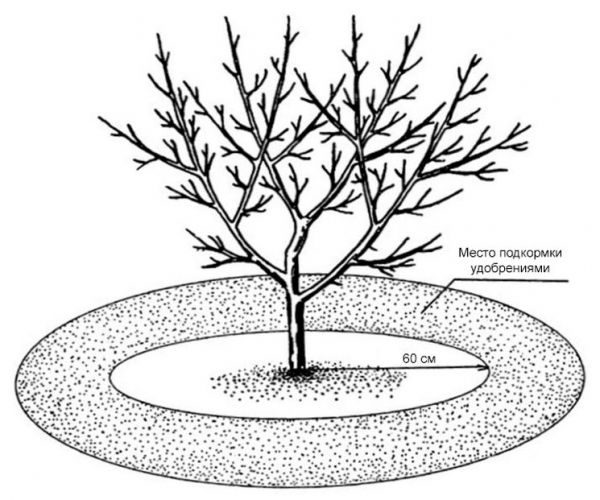

It is advisable to water in conjunction with fertilization. This will help the beneficial substances quickly penetrate the roots of the tree. It is recommended to fertilize cherries in the fall in the first days of September, until the plant has time to go into the dormant stage. This will make it possible to assimilate the fertilizer immediately, and not wait for the onset of spring.
You can fertilize cherries with compost. It is applied in the following amount:
- if the age of the tree does not exceed 7 years, add 2 kg for each square meter of the near-trunk circle of soil;
- for older trees, the amount of compost is increased to 3 kg.
Mineral complexes with a predominance of potassium and phosphorus can be used as top dressing:
- it is enough for young trees to add 1 tbsp for every square meter of soil. l. potassium chloride and 2 tbsp. l. superphosphate;
- for fruiting plants, this rate is increased by 1.5 times.
Disease prevention
Preventive treatment of cherries from diseases and pests in the fall begins with cleansing lichen, moss and loose bark from the trunk. It is convenient to perform this procedure with a metal bristle brush. Then the plant residues in the trunk circle are collected and burned. Often during this, clutches of pests are found. They are also destroyed by hand.
With a moderate infection of plants by pests, cherries are treated with folk remedies:
- ash and soap solution prepared from 10 liters of water, 400 g of ash and 50 g of liquid soap;
- a solution of 50 g of birch tar and 10 liters of water;
- infusion of 1 kg of chamomile and 10 liters of water.
If there are too many pests, cherries are treated with chemical insecticides "Karbofos", "Aktellik" or "Bankol". As a prophylaxis, the plant is sprayed with Bordeaux liquid, using a solution concentration of 1%. For young trees, 2 liters of solution is enough, and for fruiting trees, the volume is increased to 10 liters. At the same time, the trunk circle is sprayed.
Warming and whitewashing of boles
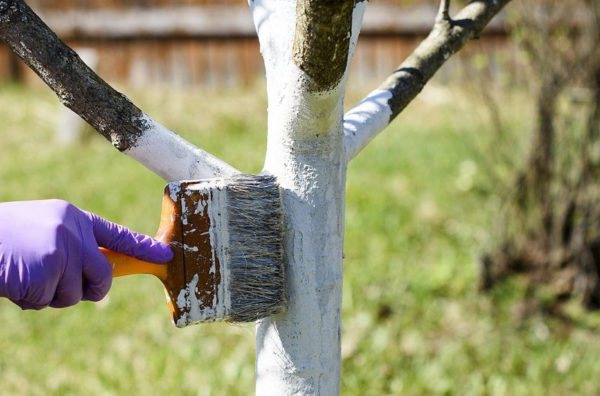

Since the climate in Russia is changeable, it is worth protecting the fruit tree from the vagaries of the weather in advance. After all, frosts that hit before the establishment of snow cover can destroy a young plant. Therefore, for young cherries up to four years old, the stems are wrapped in burlap, old newspapers and tied on top with spruce branches. Before this, it is recommended to wrap the trunk at the base with a plastic net to prevent damage by rodents.
In mature trees, trunks are whitened for additional protection. A layer of whitewash will help protect the tree from too bright sun in winter. If you add a little iron vitriol to the lime, then such a whitewash will scare away rodents. The trunks are treated with lime after the rainy season is over, so that the paint layer remains on the plant longer.
In spring, during flowering, flowers and ovaries sometimes crumble from the cherry. This is due to the high acidity of the soil. Therefore, it is recommended to apply lime fertilizers to the soil every 5 years. They will help preserve the green part of the plant.
Cherry care in autumn, including processing and feeding trees


Cherry is a cold-resistant culture, and even severe frosts can endure without any damage, however, cherry care in autumn must be carried out without fail. By taking time for the fruit bushes in the autumn months, you will get a guaranteed yield of excellent fruits for the next year and reliably protect your cherries from pests or the development of various diseases.
Fertilizers
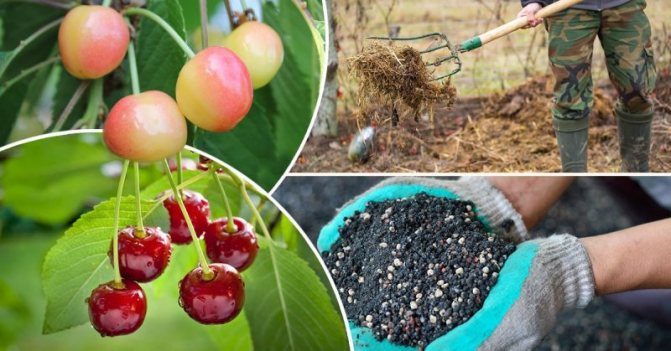

The main criterion by which fertilizers are distinguished from each other is composition. Based on this characteristic, the mixtures are divided into organic, mineral and combined.
For autumn feeding of cherries, it is allowed to use all types, except for nitrogen-containing ones:
- Organic. Allowed for cherry trees over 4 years old. The first most popular in this group is chicken droppings. Next comes compost, rotted manure, peat, sawdust.
- Mineral. The best options for cherries in the fall are complex phosphorus or potassium mixtures: superphosphate, potassium sulfate, potassium chloride, phosphate rock.
- Balanced - fertilizers containing several elements. An example for cherries is nitroammofoska.
Preparing cherry tree trunks for winter
Cherry blossoms begin early enough, with the end of the dormant period, the tree immediately actively begins to consume nutrients from the soil, therefore, preliminary feeding of cherries in autumn is more preferable than in spring. In addition, having collected the entire crop at the end of summer, you can safely treat cherry bushes with chemicals against pests and diseases, without fear for your health.
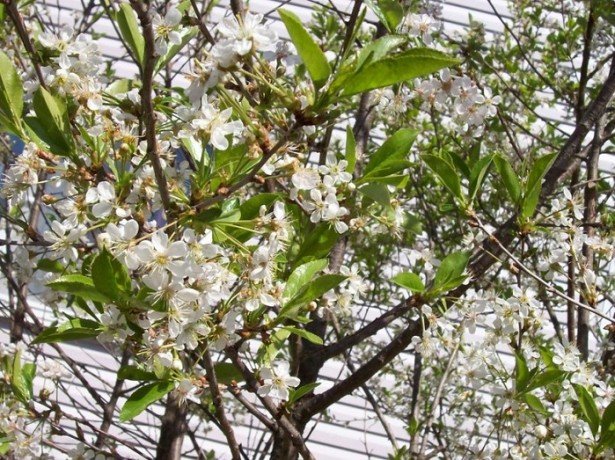

Cherry blossoms start early enough, with the end of the dormant period
Autumn cherry care includes:
- processing of near-trunk circles under trees;
- water charging irrigation;
- fertilization;
- prevention of the appearance of diseases and pests;
- pruning branches;
- whitewashing of trunks.
During the summer, you tirelessly fought the weeds under the cherry trees. With the onset of autumn, this important procedure should not be forgotten either, since sodding of the near-stem circle will have a bad effect on the future development and fruiting of cherries. To prevent the appearance of weeds, you can mulch the ground under the cherry tree even in the summer, just make sure that the mulch does not cover the trunk, otherwise it will start to rot.
Cherries in the fall need deep digging of the soil. However, do not overdo it - you do not need to dig deeper than 15 cm, because the roots of cherry bushes are located just below this level, and it is very easy to damage them. The diameter of the loosening should correspond to the crown of the tree.
After loosening, spend the final watering of the cherry so that the moisture penetrates deep into the roots. To do this, at least fifteen liters of water will need to be poured under each adult tree, and eight liters will be enough for young seedlings.
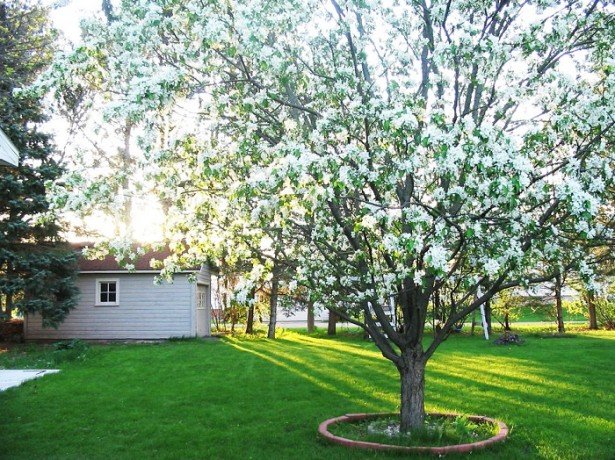

Cherries in the fall need deep digging of the soil
How to get rid of cherries in your garden forever
What to do if it is necessary to remove an old, diseased tree or bush, and so that in the future the root shoots do not interfere with other plants? The removal of the root system raises special questions - after all, individual roots can reach 3-5 meters in length. To represent the size of the roots, be guided by the size of the crown. If the height of the cherry is 2 meters, then the roots are about the same length. Step-by-step instructions for uprooting a cherry tree:
- They order a tractor.
- The tree is filed, leaving the trunk at a height of 1–1.5 meters.
- Carefully dig in large roots. This is to make the plant easier to pull out with all the roots.
- Tie the tree to the tractor with a strong rope.
- A tree is being pulled out.
This method is quite effective. Only small roots remain in the ground, which alone are not ways to survive. The site can be processed for the following plantings.
Manual root removal is not effective and will require a lot of time and effort.
There are also recipes with salt:
- Remove the crown from the tree.
- Dig in a tree, chop off large and medium visible roots.
- Swinging the trunk, chop off the roots that are closer to its center.
- After the maximum of the roots has been cut, cut the trunk as low as possible.
- Sprinkle the stump with salt, wrap with cellophane.
- Leave for a year.
- After a year, the stump will rot.
A significant disadvantage of the method: soil salinization is not beneficial for plants.
How to remove cherry roots without uprooting
Without uprooting, there is only one way to destroy the stumps and roots of old or unnecessary plants: chemical. Wood residues are burned with a strong oxidizing agent - nitrate. It allows you to destroy even deep roots. The procedure is simple: in the stump or the remains of a tree, in early autumn or late summer, many holes are drilled. Potassium or sodium nitrate is poured into the resulting pits, poured with water to make it better saturated, wrapped in a film, and tied.
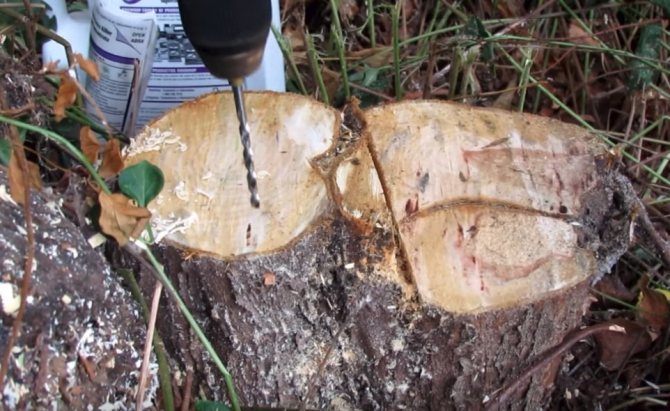

Holes are drilled along the perimeter of the stump for laying ammonium nitrate
A medium-sized tree with a trunk of 15 cm in diameter requires 2 kg of nitrate.
The stump treated in this way is not touched until next summer. During this period, all the roots and the stump itself, under the influence of the substance, will dry out. Wait until the tree is completely dry after the rains. Now it is enough to make a fire near the stump. When it completely burns out, the soil is dug up. That's all - the place is completely free, you can not be afraid of the appearance of cherry root growth.
Instead of ammonium nitrate, you can take urea. The sequence of action is the same.
Despite its effectiveness, the method has drawbacks. Saltpeter is a good fertilizer, but during the time it acts on the stump, the soil is oversaturated with it, which can be harmful to many fruit or tuber crops.
Observe safety measures when working with chemicals!
How to feed cherries in autumn?
After digging the trunk circle, you can start feeding the cherries with fertilizers, and the introduction of nutrients can be carried out at the same time as watering. According to horticultural experts, feeding cherries in the fall is extremely important for their proper growth and development, and also contributes to obtaining a wonderful harvest.
It is advisable to have time to make the last fertilizing of the cherry for the season at the beginning of autumn - feeding the tree later, you thereby increase the period of its sap flow, and as a result, the cherry can poorly endure the winter.


After digging the trunk circle, you can start feeding the cherries with fertilizers
How to feed cherries in autumn to provide them with sufficient nutrients until spring:
- Organic matter is considered the best option for autumn feeding: rotted manure, sawdust, compost, bird droppings diluted with water;
- if you do not have the opportunity to get natural organic fertilizers, complex dressings, which are specially designed for fruit trees and shrubs, are also suitable;
- fertilizers with phosphorus and potassium should be added to the soil at the stage of autumn digging so that they are deep in the ground;
- it is better to leave nitrogen fertilizers and ash for spring feeding, because they are necessary to accelerate flowering and fruiting, and now you need to preserve and strengthen the roots of the cherry.
Autumn water-charging irrigation
It is also called "water-charging" irrigation or "winter" irrigation.
Autumn water-charging watering of cherries is another useful activity that allows you to better prepare the tree for winter by “filling” it with moisture. The fact is that moist soil freezes less and has greater thermal conductivity, in other words, the heat from the lower layers of the soil will warm up the roots of your sweet cherry in the cold period.
Thus, water-charging watering is recommended for all fruit trees and berry bushes.
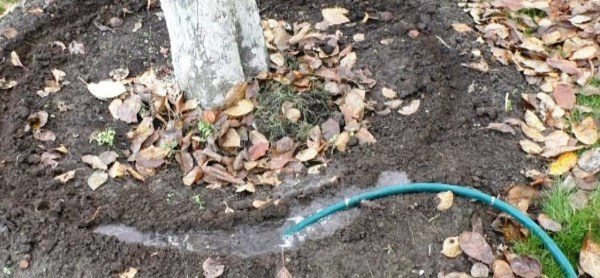

How long does it take?
- With the beginning or after the fall of leaves, on the eve of cold weather (at a positive temperature).
When is winter watering especially necessary?
- In case you have sandy loam soil and autumn does not pamper with frequent and heavy rains, and winter is not snowy.
It is worth understanding! Of course, if the autumn is very rainy, then you can completely do without water-charging irrigation.
How much water is required?
- Approximately 40-100 liters of water per 1 square meter of the trunk circle (for young - 40-50 liters, for adults - 80-100 liters), i.e. you need to calculate the area according to the projection of the crown (its perimeter). The more mature and massive your tree is, the more water you need: about 50 to 200 liters.
Advice! Naturally, you don't need to carry any buckets: take the hose and move it around the trunk circle (and first measure how many minutes it takes to get one 10-liter bucket. For example, if in 30 seconds, then 5-10 minutes will be quite enough).
And after watering (for example, the next day) it is very desirable also loosen the soil in the near-barrel circle, because loose earth freezes less.
Of course, if you have a good layer of sod under the trees or grass (lawn) just grows, then you do not need to touch it.
Video: what is water-charging irrigation and how to carry it out correctly
Autumn processing of cherries against pests and diseases
The fragrant and beautiful cherry is a real find for a large number of garden parasites, which deprive it of its blooming appearance, eating with appetite on the trunk, leaves, flowers and even set fruits. Of course, cherries require proper processing all year round, especially at the time of flowering and ovary, when it is important for you to keep it healthy by all means. However, it is the processing of cherries in the fall that is the most important prevention against most annoying pests, as well as widespread diseases.
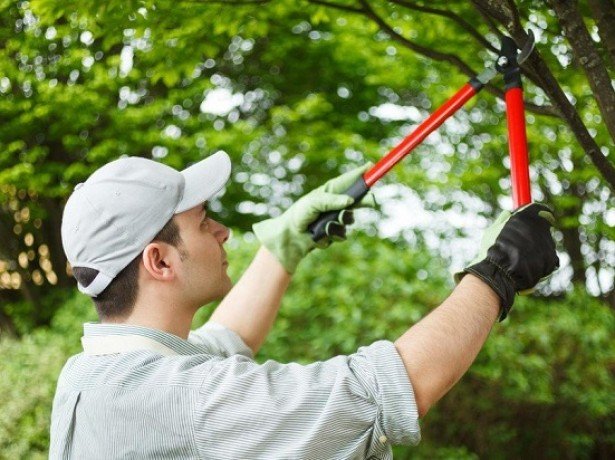

Cherries require proper processing all year round, especially at the time of flowering and ovary
The main stages of the autumn processing of cherries from pests:
- when the leaves fall off the cherry, they carry out sanitary pruning of branches, removing diseased and damaged branches, covering the cut site with garden pitch;
- clean up and cover up cracks and wounds in the tree, from which gum flows;
- all plant residues, including fallen leaves, cut branches and diseased fruits, are removed from the trunk circle and destroyed;
- after the first frost, the cherry bush and its near-stem circle must be sprayed with a 5% urea solution - this high-concentration nitrogen fertilizer destroys a large number of pests, fungal and infectious pathogens and prevents their reproduction.
If you are concerned about the question of how to treat cherries in the fall against certain pests or pathogens, in the corresponding article you will find the names of the drugs and more detailed methods of dealing with the most common misfortunes.
Autumn pruning of cherries
Most experienced gardeners agree that all fruit trees, including cherries, are recommended to be cut in the spring, and not in the fall.
Autumn pruning is dangerous for fruit trees: the cuts do not have time to grow and prepare for low temperatures, as a result, during severe frosts in such places, the tree freezes out.
There is also a common, but not indisputable, rule that in the fall you can cut pome trees, but stone fruits only in the spring.
By the way! The site has a detailed article about how to properly shape and prune cherries in spring.
But in general, in the fallusually spend only sanitary pruning of cherries, i.e. get rid of dry, broken and diseased branches (especially affected moniliosis, which have a monilial burn).
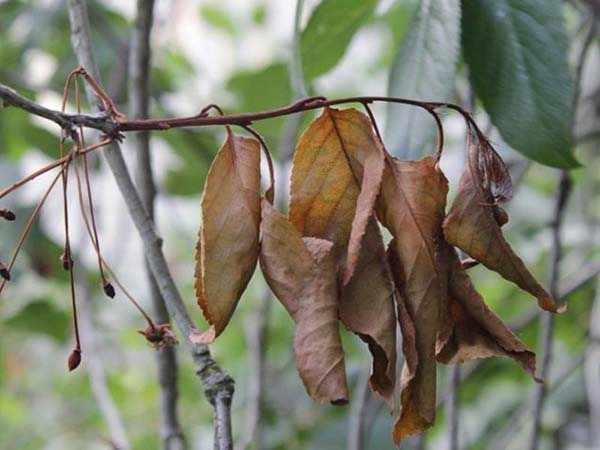

Prepare your tree for winter
Despite the high resistance of many cherry varieties to severe frosts, in winters with little snow, trees can still suffer from severe cold. Therefore, in late autumn, try to form a good protection of the roots and trunk of the cherry from possible freezing. The usual shelter of the cherry tree trunk circle with a thick layer of snow will help to cope with this task. Sprinkle the formed snowdrift with light mulch (sawdust or small straw) on top for reliability.
For additional protection of the cherry trunk from the active influence of the spring sun, and at the same time from pests and rodents, the stem is whitened with a simple solution of lime, or iron vitriol, mullein, and clay are additionally added.
If you were not too lazy and took proper care of cherries in the fall, this beautiful tree will surely reward you for your hard work next season: in the spring it will fill your garden with snow-white radiance and a wonderful aroma, and in the middle of summer it will bring a good harvest of juicy fruits.
Shelter for the winter
Experienced gardeners advise not to rely on the winter hardiness of this culture and to cover the fruit tree for the winter in late autumn. This is especially recommended for young cherries. Usually trees are covered with mulch. Young plants are additionally tied with spruce branches. The mulch is positioned so that it does not touch the tree trunk. Otherwise, during thaws, the bark will undermine and rot will begin.
In this way, bush and felt cherries are covered before the onset of frost. The tree-like culture is additionally wrapped in light burlap, white paper or non-woven covering material. This precaution will protect the tree from mice and other rodents.
Using folk remedies
Among the people, in addition to manure and chicken droppings, the following means are used:
- Eggshell. A valuable source of calcium is harvested all summer long and dried. Then they are ground in a mortar into small crumbs and scattered around stone fruit cultures. The shell reduces the acidity of the soil, improves plant immunity.
- Yeast. The element helps to increase the activity of microorganisms living in the soil. Yeast is introduced along with warm water on a warm autumn day.
- Infusion of garlic and onion peel. It is rather a folk remedy for pests.
- Sawdust. They are introduced in the fall as mulch, as well as for the purpose of obtaining loose soil.
Inorganic additives
Urea
Urea (carbamide) contains up to 46% nitrogen, which is very important for the growth of green mass. Urea is often combined with potash fertilizers, which forms a complete nutritional complex for spring feeding of fruit trees. In addition to nutrition, urea protects seedlings from fungal mold - coccomycosis. Trunks and branches are treated with it before the first frosts.
Superphosphate
Superphosphate contains up to 50% phosphorus compounds, useful for the development of seedlings. Phosphorus contributes to the development of a strong root system (especially important for young seedlings) and improves the palatability of the fruit. With a lack of phosphorus, the leaves become covered with yellow spots and acquire a purple hue. However, superphosphate cannot be used together with urea, chalk and nitrate. A week should pass between fertilization.
Potassium salts
Potassium salts ensure the resistance of seedlings to frost, so they must be added in preparation for winter. However, the dosage should be strictly observed, because an excess of chlorine (included in the composition) negatively affects the well-being of cherries.
Ammonium nitrate
Ammonium nitrate replaces urea, as it contains a sufficient percentage of nitrogen. The potassium content has a beneficial effect on the taste characteristics of the fruit and on the active planting of the crown.


Fertilizers by season
In the spring, nitrogen must enter the soil for the trees to grow foliage. Fertilizers for cherries are applied by the root method, since there are still few leaves in the spring, and the tree will not be able to absorb the substances. Before the start of the movement of juices, organic matter or minerals are introduced in full. Minerals are scattered in the area of the near-trunk circle and are added in drops to eliminate nitrogen losses.
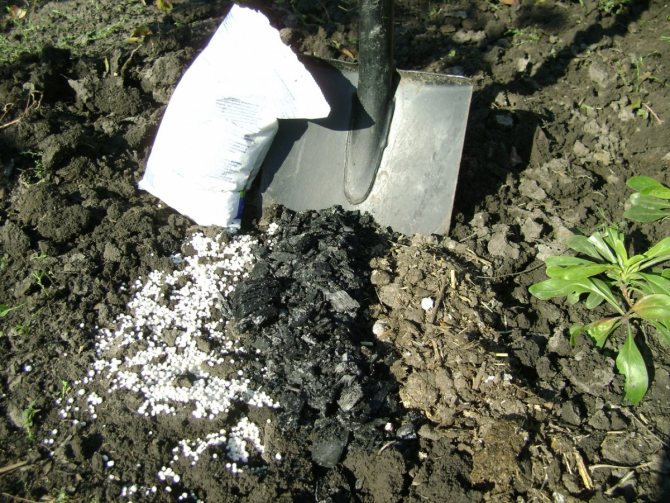

Organics are laid out and also dug up with the soil. If there was a lot of snow, it means that the soil is wet and soil bacteria will immediately begin to process substances. Otherwise, it is necessary to water the ground so that the food gets to the roots.
The first fertilizer is enough before flowering. Fertilizing cherries after flowering should contain more potassium and phosphorus, since these substances are responsible for the number of fruits and their taste. At this stage, the gardener's task is to influence the safety of the ovaries, their growth. Taste depends not only on the availability of nutrients in the soil. The variety also affects: there are sour varieties, sweet and hybrids of cherries and cherries.
How to feed cherries with folk remedies in the summer:
- Wood ash is a perfectly balanced organic matter, the most popular folk remedy. Contains all the necessary nutrients that fertilize cherries and all stone fruit trees in summer. To get it to the roots faster, you need to make a solution: pour 300 g of ash with a bucket of water and leave for a week.
If the tree is large, then you need two to three times more ash, then dilute with water. Before application, the soil is watered abundantly. Next, a hollow is dug along the near-trunk circle and the ash solution is poured into the ground, the depression is closed with a layer of soil.
- Compost, if used in a household, is dug up with soil and watered.
- It is also better to add humus to the soil, rather than just leaving it on the surface. If the fertilizer is mulched with straw and watered, then the loss of nutrients can be avoided.
Of the minerals, potassium sulfate and superphosphate are used: ordinary or double. About 50 g of superphosphate and 40 g of potassium are needed per square meter. Substances are dissolved in water and poured onto the soil.
How and why the plant is protected before the onset of winter
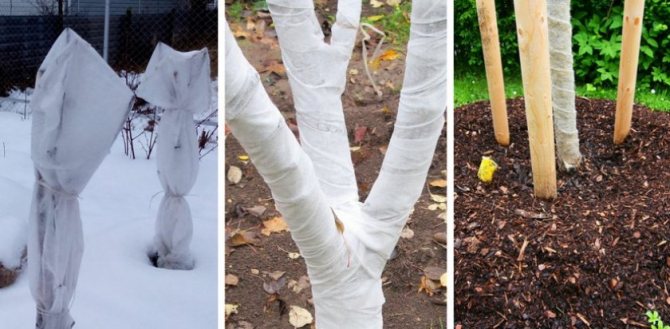

The main autumn care procedure is to properly cover the cherry seedlings for the winter. At the same time, adult plants do not cover: the massive crown and high height will prevent the summer resident from doing this. But the fragile young seedlings should be insulated, and this does not depend on the climatic conditions in which the culture had to be planted.Shelter is carried out in all areas where the temperature remains at -25 ° C for a long time during the winter months. It starts when the thermometer shows a slight minus.
Shelter of the cherry tree for the winter allows you to prevent freezing of plantings, and also protects the bark from rodents, diseases, pests.
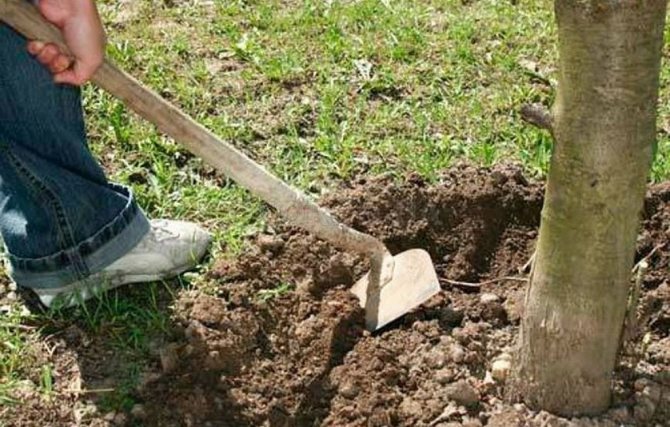

The defense is carried out in several stages:
- Mulching the space at the trunk. Usually, the near-trunk circle of cherries is recommended to be covered for the winter with a 5 mm layer of peat or manure. Some gardeners put soil, sawdust or humus under the bole with a layer of about 25 cm.
- Insulation of the cherry trunk. It is covered with spruce branches or wrapped in breathable material (for example, burlap). To prevent the ingress of icy air, the bottom of the shelter is covered with earth.
- If possible, the branches of a young plant are bent to the ground, wrapped with a film frame. Spruce branches are placed on top. Then sprinkle the entire structure with a 40 cm layer of snow.
- They also build special frame shelters. The bars are driven in around the tree, and then covered with protective material. Before the plants are covered, it is checked whether the space necessary for air circulation remains between the crown and the shelter.
- Shoots of adult trees are tied up, wrapped in polyethylene. Sometimes a box made of plywood is installed on the culture.
Interesting!
Videos and photos showing all the stages of the process will help warm cherries for the winter.
If suddenly it was not possible to carry out measures to warm the culture, then further actions are advised to be taken taking into account the duration of frost. If the thermometer does not rise and the snow does not melt, it is advisable to throw it over the trunk. This will help insulate the stump area. If forecasters predict warming, it is better to install a box or wrap the plant with insulating material, completely covering the crown.
How to prepare cherries for the cold season - insulation
After the preparatory stage, we are already preparing for the winter thoroughly. The easiest way to insulate a cherry is with a regular snow cover. It is the snow that helps to maximally protect both branches and buds from freezing. If there is enough rainfall, then you will need to cover all branches as evenly as possible. There is only one caveat - cherry shoots need to be bent in a circle or according to the "fan" principle.
Which option to choose depends on what kind of cherry you have.
If your winter usually passes without snow, you can use tops or straw. There are usually plenty of plant residues in every garden, so it will not be difficult for you to prepare them for these purposes. Sand or soil is usually also poured on top of such a layer. Some people cover the tree trunk with a special bag or thermal insulation material.
So try to choose one of the above options. If you have enough snow, then you will periodically need to add some snow to the roots of the cherry seedling. So you will save the root system of the tree from the cold and thereby help the fruit plant to winter well. - a separate topic, which is covered in an article on our website.
Terms of work
It is recommended to fertilize cherries immediately after the final harvest, removal of dry branches and careful digging of the trunk circle. With a later implementation of this procedure, the sap flow processes are significantly accelerated, as a result of which it will be more difficult for the tree to withstand frost. Ultimately, this can negatively affect future yields.
The optimal time for autumn feeding, which will ensure the full development of the tree, is the beginning of September. During this period, cherries are most prone to the perception of organic and mineral fertilizers, the composition of which is determined depending on the state of the soil and climatic conditions.
Note! In regions with a fairly short autumn, it is advisable to apply the necessary fertilizers before the end of August, since with early freezing of the soil, the benefits of late feeding will be minimal.
At the same time, you should not start fertilizing the tree earlier than the recommended period, since nutrients that are not used for their intended purpose will lose their beneficial properties.
If the cherry was planted in compliance with all the rules, then the reserve of the minerals initially laid in the ground should be enough for the next 2-3 years. During this period, additional feeding is not required.
Features of wintering in the regions


Sweet cherries have always loved a warm climate, so it is good to plant and grow them in the southern regions and when sheltering for winter in the Middle lane. But thanks to the breeding of frost-resistant varieties, sweet cherries were able to spread to more northern regions, such as Kuban, St. Petersburg, Khabarovsk. But, despite the frost resistance, it is necessary to correctly cover the young cherries for the winter, and process the adult trees to the possible height.
You can properly cover the trunk of a sweet cherry for the winter by removing various kinds of moss, lichens and other debris from it. After that, pour sawdust or needles under it, and treat the trunk itself with breathable material (burlap or agrofibre). You can not use the film, as the tree underneath it will push. There must be a gap between the barrel and the covering material for air circulation. Also, this type of insulation also serves as protection against rodents.
It may be interesting How to grow cherries from stone at home
Caring for cherries in autumn and preparing seedlings for winter or young trees, consists in the construction of an artificial shelter:
- to make it more compact, collect the branches, if possible, in a common panicle;
- drive frame stakes along the perimeter of the tree;
- wrap these pegs with covering material (burlap, spunbond) to the very top, as a result, you get a covering cone;
- additionally, you need to cover the cherries for the winter with a layer of snow.
To understand in more detail how to insulate cherries for the winter, the video will show. In regions with a strong drop in temperatures, for example, in the Urals, in Siberia, cherries must gradually be transferred to a creeping form. To do this, in the fall, cropping must be carried out using a special technology, which can be seen in the photo. And for the winter, bend the branches to the ground and cover with a covering material, throw spruce branches and snow on top, the layer of which should be at least 35-45 cm.
What and how to cover cherries for the winter to protect them from frost?
Before proceeding with the shelter of the cherry, it is recommended to bend its branches. At the same time, old branches, which are more than eight years old, are cut out, leaving up to five young branches for replacement and the main fruiting branches. The pressed branches are sheltered from frost with straw or tops.
- At the branch, they bend in a circle - in the spring they will keep the slope and in the future it will be easier to bend down.
- Low-growing forms of steppe cherry can be bent both in a circle and fan-shaped.
- An ordinary cherry is also bent in a circle.
- In sand cherries, the branches are bent down in a fan, and when frost sets in, they are collected in a bunch.
To protect the cherry root system from frost, it is enough to cover the soil under the bush with a thick layer of snow, from time to time shoveling up the snow to form a voluminous snowdrift.
Additionally, you can cover the cherry trunk with a cover made of ordinary burlap, or simply wrap the stem with paper. With the arrival of spring, such shelters must be removed immediately so that the cherry does not suffer from the accumulated condensation.
It is especially important to take care of the shelter for the winter of young cherry seedlings. In the first year, be sure to mulch the tree trunk circle near the cherry with peat, sawdust, or at least just a good layer of earth, and sprinkle it with snow as soon as possible.
Experienced gardeners recommend mulching snowdrifts under cherry sawdust or small straw - light mulch on top of the snow will help the ground stay frozen longer, and cherry blossoms will begin to bloom ten days later than usual. Too early flowering is undesirable for the reason that with spring frosts, delicate flowers run the risk of freezing, then a bountiful harvest of fruits can not be expected.
Video about preparing the garden for winter
Do not forget that a big role in how successfully a young cherry tree will survive the winter cold is played by the place on the site that you allocated for planting it. So, the chances of a successful wintering increase significantly if the cherry is reliably protected from strong winter winds. But it is better not to plant it near the fences so that the bushes do not turn out to be covered with snow to the very top.
Preparing cherries for winter
also necessarily includes water charging irrigation. Watering is necessary after the leaves have fallen and the cherry tree trunk has been digged, using up to 15 liters of water for each adult bush (8 liters will be enough for young seedlings). Such abundant watering will help the cherry bushes winter better.
Many inexperienced gardeners are of the opinion that if the plant is bearing fruit, then it is not worth taking care of it.
In the autumn the first action should be to loosen the soil near the trunk
... The growth and active development of the tree, the formation of large fruits depends on the quality of the soil.
The soil is periodically loosened as needed. In order for the roots to receive a sufficient amount of nutrient moisture and oxygen, the earth is dug 8-10 cm deep. If the site is saturated with heavy, dense soil, then the digging depth increases to 10-15 cm.
Worth knowing!
Fertilizing the plant in the autumn should also be done on time. If you feed too early in the fall, the nutrients will begin to decompose and be absorbed by the root system. Such a process will provoke the active growth of sweet cherry branches, which will postpone the retreat period for wintering. Therefore, feeding is necessary when the air temperature begins to tend to 0 C.
Be sure to water the sweet cherry
... If the weather conditions do not please with rain, the earth dries up, then the plant must be irrigated with moisture before switching to the winter period.
It is recommended to water thoroughly before freezing or add the required amount of nutrient moisture using buckets, most often in the amount of 10 buckets. This amount will saturate the near-stem soil by 1-15 meters. Then, in winter, the soil will not freeze, and with it the roots of the plant.
The last step before preparing for wintering is fertilization
... The following scheme should be adhered to:
- 1-4 years - organic feeding up to 20 kg, phosphorus and potassium - 100 g;
- 5 years and older - organic fertilizers - up to 50 kg per plant, phosphorus - 400 gr., Potassium - 150 gr.
Improper feeding negatively affects the development and fruiting of cherries. In this matter, the main thing is not to overdo it. In the autumn period, nitrogen fertilizing should be categorically abandoned. You can lead the plant to abundant growth of branches, which will entail freezing of young growth.
Pruning of a young cherry seedling is carried out every year. Timely pruning allows you to get a quality harvest. At the same time, fruiting increases and immunity is strengthened. In addition, by removing unnecessary and diseased branches, the old seedling is rejuvenated and, as a result, its life is prolonged.
Many gardeners ask themselves the question: "When is it more correct to prune cherries - in spring or autumn." Removal of part of the growth is required to be done both in the spring months and in the autumn.
In the spring, at the beginning of March, a sanitary cleaning of the branches broken or frozen over the winter months is carried out. In April, the formation of a crown is required, so all excess young shoots are cut off, as well as those that thicken, grow inward, interfering with the skeletal branches.
Why pruning cherries in the fall:
- Formation of strong skeletal branches.
- Improving the fruitful culture.
- Protection against diseases and harmful insects and their larvae.
- Thinning of young growth, which does not allow the fruits to be saturated with sunlight.
- Keeping the crown from overgrowing.
- Even distribution of branches around the entire perimeter of the trunk.
Attention!
It is necessary to carry out the autumn pruning of cherries after all the foliage from the branches has fallen. Do not delay the procedure. It ends before the first days of October. This is necessary so that the resulting wounds have time to heal before the onset of the first frost.
Removal of unnecessary growth is carried out either by shortening, or by thinning out excess branches. According to the last method
all incorrectly grown branches are removed. They should grow at an angle of 40-50 0 to the outer bud. All internal eyes are removed so as not to thicken the skeletal structure with unnecessary branches.
Shortening method
requires the removal of 1/3 of annual vines that have grown to a length of more than 60 cm. If the tree has not been cut for a long period of time and is overgrown, then it is recommended to apply not one of two methods, but two at the same time.
An important point
, it is necessary to cut not to the detriment of the plant. Have time to complete all procedures for the removal and formation of the crown before the cold snap sets in.
When cutting off layers, use pruning shears, saws, a garden knife
... All tools must be sharpened carefully. So they cause less damage to the bark of the fruit crop.
For quick healing of wounds, use a garden var
... It allows you not to lose the nutritious sap and prevents pests from entering the tree.
Video: how to properly prune cherries in the fall
The first autumn pruning is carried out immediately after planting a young cutting.
So, the height of the seedling is reduced to almost 1 meter in height. This will allow not to waste energy on additional branches, but to direct all the juices for high-quality rooting. Longer removal is not advisable, there is a possibility that the plant will not have time to take root and will die during the first frosts.
The picture below shows the schemes for pruning cherries as the tree matures.
Until the cherry is 5 years old, all its branches should not exceed 50 cm.And the processes that do not affect the total crown of the tree are cut off to 30 cm.The best distance between the formed skeletal trees should not exceed 30 cm. The main thing is during removal. branches should not be removed growth eyes. Otherwise, you can provoke the drying of the entire branch.
Pruning scheme for young cherries


If the plant is old, pruning is carried out for the purpose of rejuvenation.
... This procedure is carried out once every 5 years. To do this, remove all old and dried branches. You should also remove all old knots that are over 6 years old. All sections are required to be covered with garden var.
Video: pruning old cherries in autumn or spring
By the way!
After trimming, it is recommended to anoint the base with lime. This will prevent burns on the bark during the bright winter sun. And also such a measure will protect against damage to the bark by rodents.
Thus, autumn pruning is not only necessary, it is also important for future fruiting and crown formation
... In addition, old cherries tolerate pruning more easily in September than in March. But it is recommended to perform all procedures 3 weeks before the onset of cold weather, so that the sections have time to tighten.
Video: pruning cherries in the fall for beginners
Sweet cherry in most cases does not like a strong drop in air degrees. Older trees are less sensitive to frost. While young growth often suffers from frost. Therefore, young cherry seedlings in any regions are subject to shelter for the winter. This will protect the young from freezing of part of the branches or from kinks under the weight of the snow that has fallen.
Important!
Before starting to cover the cherry for the winter, the soil under it is loosened, well spilled with water and fertilized, the old bark is cut off and lichen formations are removed. Only after all the procedures can you start warming.
Preparing cherries for wintering includes the following points:
- The ground around the trunk of the cherry tree is covered with natural material
- peat, pine branches or sawdust. The coverage area is the width of the tree crown - as far as the branches stretch, the root system grows in breadth. - Rodent protection in progress
- next to the seedling, pegs are driven in with the height of the plant. The crown is lightly tied by branches, giving the shape of a column. - Covering material
- a covering material is wound around the driven stakes, so that a kind of cylinder is formed. The plant is completely enveloped from the top to the very base so that the animals cannot penetrate inside. From below, peat or earth is poured onto the base of the covering material, so that it cannot be lifted from the ground. - Fallen snow
- after the first snowfall, snow is additionally superimposed on the base of the covering material with a snowdrift. It serves as an additional insulation.
The main thing is that the wrapped tree is packed in such a way that there is enough air inside. Then the plant is not afraid of any frosts. Otherwise, with a strong contraction of the upper material, you can provoke a debate of foliage and bark. The latter will lead to the onset of a fungal disease.
Fertilizers for cherries
Autumn feeding should provide the tree with such an amount of nutrients, which will be enough for the entire cold period. To do this, use:
- organic fertilizers in the form of manure, compost that have rotted for 2-3 years, as well as chicken manure diluted in proportions of 1.5 kg per 4 liters of water;
- minerals based on phosphorus and potassium, which must be laid at a considerable depth in order to ensure their access to the roots;
- ready-made complex dressings designed specifically for growing fruit and berry crops.
It is categorically not recommended to use nitrogen substances in autumn, since this can disrupt the process of timely entry of cherries into a state of winter dormancy.
Fertilization rates depend on the age of the plants. For trees not older than 4 years, the following single dosages are provided:
- Phosphate-potassium dressing - no more than 100 gr.
- Any kind of organic matter - within 15-20 kg.
For cherries that have reached 5 years of age, the calculation of the norms looks like this:
- Phosphorus is used in an amount of 400 gr.
- Potassium dosage should be no more than 150 grams.
- Organic fertilizing is applied at 40-50 kg per adult tree.
You should not exceed these calculations, since an oversupply of fertilizers can lead to a decrease in fertility.
Warming
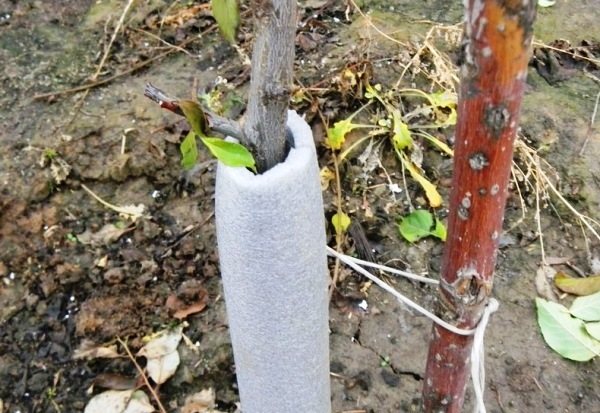

Novice gardeners need to understand how you can cover cherries for the winter if they did not manage to do it on time. Further actions will depend on the duration and persistence of frost. If a decrease in temperature is not expected, and the snow will not melt, then a snowdrift must be heated around the trunk, it will protect the near-trunk zone from freezing. If the temperature is not constant and soon the snow will melt, then in such a situation it is better to insulate the trunk with a covering material or use a box. All young cherry seedlings or thermophilic varieties need such insulation.
Attention!
Frost-resistant types of cherries in the middle lane are enough to whitewash and heat a small snowdrift into the base of the trunk. By the same principle, it is necessary to prepare cherries for winter in the Moscow region.
It is worth preparing cherries for wintering through the implementation of moisture-charging watering of the plant. The moisture from the tree evaporates all year round, although in winter it is not as intense as in spring and summer.But trees that are not nourished are dried out faster under the influence of low temperatures. Wet soil freezes less and has higher thermal conductivity.
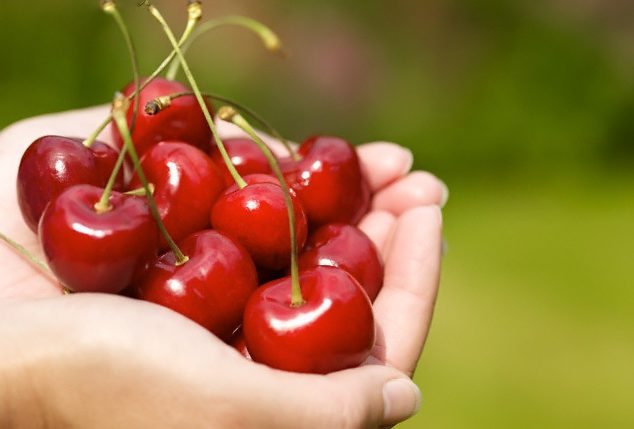

Additional nuances for tree preservation
Starting from the end of summer, it is not recommended to water the tree often - this can only harm. As for loosening the soil, this process must be approached carefully. After digging up a piece of land near a tree, you can simply damage the roots. This procedure should be started with feeding from the beginning of autumn. Fertilizers you need phosphorus and potash. If you are using, for example, manure, compost or humus, then you will need to add a layer of soil on top of it.
After loosening, you need to water the cherries. Keep in mind that it is not worth pouring water over the fruit tree - one to two buckets of water will be enough. If there is mulching material next to the tree, move it to the side so that the tree does not start to rot. Many gardeners use special tubes for watering in the form of cut plastic bottles that need to be deepened near the root.
Thanks to this, when watering, water will flow clearly for its intended purpose - directly to the root system of the cherry.
It is also important to whitewash the cherry trunk with a white solution on the eve of the winter season - we are talking about slaked lime with the addition of ferrous sulfate and clay. Old and dead branches that have been cut must also be treated - they are usually greased with a special garden varnish. Deep cracks are also covered with it, if the tree has them. All these necessary procedures should be done before mid-autumn, otherwise it will be too late later.
And do not forget that all unnecessary garbage after pruning should be thrown away, and not left under the tree in your area. Another important point is that so that there are no pests and fungal diseases on the tree, with the arrival of frost, you need to treat the tree with a 5% urea solution. Thanks to this care, very soon you will be able to harvest a decent harvest and prepare many tasty preparations, for example,.
Cherry
is one of the most common fruit crops among gardeners.
A huge number of bushes and trees of this plant are grown in the gardens. However, not everyone knows how to properly prepare a bush or cherry tree for winter.
More than once, such gardeners are faced with the problem of barren flowers. But its appearance just lies in the preparation of the plant for frost. The fact is that flower buds are formed on annual shoots. And with a slight frost in winter, they freeze too much. The flower will bloom, but there is no stamen or pistil in it, the ovary will not occur.
Of course, you must certainly understand that it is possible to achieve high yields only by making certain efforts that will be required in order to provide the tree with normal and timely care. As with most horticultural crops, the bulk of the work to prepare cherries for winter falls precisely in the fall.
At this time, you can safely:
- - do disease prevention;
- - transplant seedlings;
- - carry out pruning of cherry branches;
- - prepare near-trunk circles;
- - feed cherries, etc.
Pruning cherries in autumn
Depending on your climatic zone, this procedure should be carried out from about mid-September to the end of November. The main thing from which it is worth "starting from" is that the tree should be in a state of dormancy, but at the same time one should not wait for the onset of frost.
Pruning cherries in the fall involves removing dry, diseased and damaged branches. After this, the place of the cut on the tree must be lubricated with garden varnish without fail.
In addition, pruning in the fall can be carried out in order to thin out the crown, remove all branches that grow in an undesirable direction for you or are very afraid.Mature and dense trees also need to be "trimmed" every year, as they are rather shady, which makes the berries ripen poorly, and the tree itself weakens.
Among the subtleties that should be considered:
- - young trees should not be cut off smaller, otherwise their fruiting will slow down;
- - the branches of the lower tier should depart from the trunk at an angle, not more than 400;
- - removal of branches that claim to be the top will help create a strong skeleton of the bush;
- - a decrease in the number of flower buds accelerates the growth of cherries.
Planting cherries in autumn
pruning cherries in the fall Until now, gardeners can not reach a consensus on when it is better to plant cherries. However, most of them still believe that the autumn planting gives the best results.
Usually this procedure is done in October, when the seedling is already dormant, and about 3 to 4 weeks before the first frost. The main thing is that the cold does not fall like snow on the head.
Usually, the planting of cherries begins in the fall with dipping the roots of the seedling in a chatterbox with manure and clay, after which it can be placed in the planting pit. An important rule to consider is choosing the correct pit depth. An ideal option would be when the root collar of the bush will be located at the level of the soil and, pay attention, this is taking into account the subsidence of the soil.
Planting or replanting cherries is easy:
- - a hole with cherries is watered, and the soil is mulched with sawdust or humus;
- - put some dry earth mixed with fertilizers at the bottom of the hole;
- - in the center of the hole, install a peg (or two for tall seedlings), to which the future tree will later be tied;
- - on the north side of the peg, install the seedling and sprinkle it with earth, carefully tamping it;
- - the seedling is tied to a peg, cutting it down in such a way that, in case of soil subsidence, it does not touch the lower branches of the tree.
Preparation of near-trunk circles
You had to fight weeds near the tree almost all summer, but you should not forget about this procedure in the fall, since the sodding of the cherry tree's trunk circle in the future can negatively affect its fruiting.
To avoid such troubles, even in summer the ground near the cherry tree can be well mulched, and in the fall it is good to dig it up, but no more than 15 centimeters deep. After that, the soil must be loosened up and all this must be completed by watering the cherries in such a way that the moisture “reaches” the roots themselves.
Fertilizing cherries in autumn
how to plant cherries in autumn The tree-trunk circle has already been dug and do you think that this is the end of caring for cherries in autumn? Far from it, no! A good gardener is not limited to spring feeding of cherries.
In autumn, it is very important to feed the trees, which can be combined with watering. Such a simple and uncomplicated process will contribute to the correct growth of the tree and ensure a good harvest next year.
The most optimal fertilizer options to use:
- - at the stage of autumn digging, potash and phosphorus fertilizers can also be applied;
- - organic matter: compost, rotted manure, sawdust, diluted bird droppings;
- - in the absence of natural fertilizers, they can be replaced with purchased ones;
- - ash and nitrogen substances are best kept until spring, since their purpose is to accelerate flowering and strengthen the root system of cherries.
Autumn prevention of diseases
Caring for cherries in autumn in pest control consists of the following stages:
- - removing all leaves, cut branches and other plant debris from the trunks;
- - removal of all diseased and damaged branches after foliage has fallen;
- - cleaning and wrapping up all wounds and cracks in the tree;
- - spraying the trunk circle with 5% - with a urea solution upon the onset of the first frost (this will help to destroy a fairly large number of pests).
Watering the plant
- an important part of the care, it must be carefully and carefully carried out in the fall. Avoid over-feeding and watering in the summer, this will affect how it gets through the winter. If you want to cover a young seedling for the winter, mulch the tree trunk using either soil or peat with sawdust.
Sprinkle the trunk with a layer of earth and snow, mulch the snow layer with sawdust. The latter action is optional, but it allows the ground to remain frozen longer. An adult cherry tree does not always require special care in the fall, while seedlings without it can freeze.
Each action to insulate a tree in the autumn period should be performed, since without cutting off the branches, you will not prevent infection of healthy branches by sick ones, without treating the near-trunk circle, the plant will weaken from weeds and lack of fertilizers, without insulating the trunk, branches and circle in autumn, you can be left without a crop next year.
Moreover, if you decide to plant it in the fall. The climate in recent years cannot be predicted. So it is better not to be lazy, and take care of both the tree itself and your harvest.
How to trim correctly
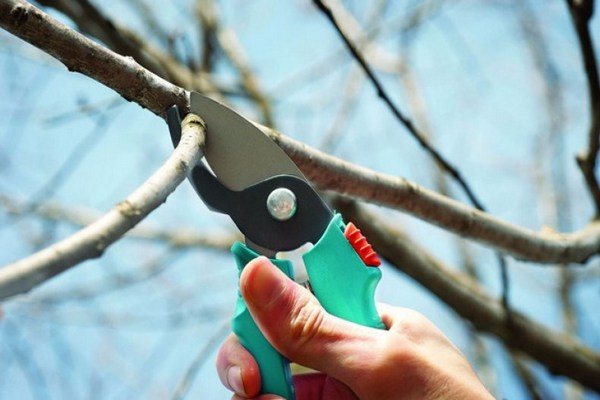

The key to successful pruning is timing. The air temperature should drop to 8-10 degrees, but not colder. Usually the right time is late September and early October. If you prune the cherries before the heat subsides, the branches will sap and the tree will be severely damaged. Late pruning also has negative consequences: the shoots become brittle, break easily, and the crop suffers significant damage. The procedure is carried out as follows:
- remove old, damaged branches that interfere with the normal formation of other shoots;
- remove those branches that depart from the trunk at an acute angle;
- last year's branches rejuvenate a little, shortening them by a few cm.The total length of the shoot should be 50 cm.
After pruning, the cut sites are poured with garden varnish or treated with a solution of potassium permanganate. If you do not protect the culture in this way, then an infection will easily penetrate into a fresh wound, which will cause disease on the cherry.
Attention!
Wait until the crown has completely shed before pruning the cherry.
Pruning for old and young trees
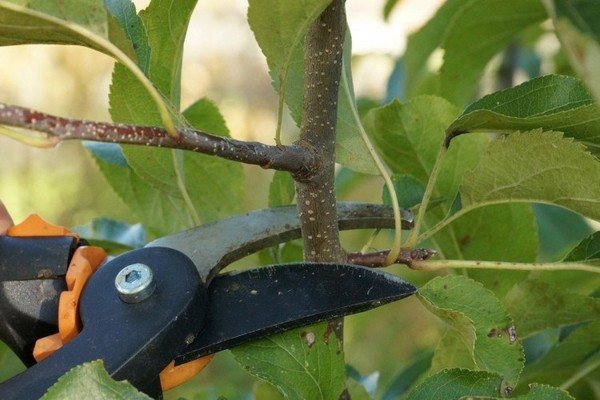

The age of the cherry affects pruning, so it cannot be ignored. Even the choice of instrument depends on whether the cherry is young or old:
- a knife is used to trim young trees;
- adult crops are pruned with a pruner or saw.
If cherry seedlings were planted recently and they are not yet 2 years old, you cannot cut the branches. With the onset of frost, the cherry will die. Landings from 2 years old and older are cut once every 2-3 years. Most of the shoots are cut, leaving only the strongest healthy branches. If a cherry tree grows on the site, which is already several years old, then a growth is formed from it. Its appearance is undesirable: the tree spends energy on its maintenance, which negatively affects the yield. When cutting off only the ground part of the overgrowth with pruning shears, the shoots will reappear after a while.
An effective method of dealing with unwanted growth is uprooting. In the fall, shoots are dug up to the place where they connect to the horizontal root and chop them off with an ax, you can use a shovel. The stumps should not be left, and the place of the cut is poured with pitch. The hole is again buried with earth and left for the winter.
Pruning different varieties
There are several types of wood and this fact must also be taken into account. The following nuances are observed:
- tree crops are pruned in the usual manner with the onset of autumn. The branches are cut at an angle, the crown is formed in a vase-like shape. Annual shoots do not bother or are shortened slightly, then lateral branches with new bouquet branches will form;
- felt varieties are cut by shortening mainly in mid-September;
- bush cherries are pruned in the fall, the crown density is controlled, therefore, shoots that compete with the main trunk are pruned. If the seedlings are still up to 2 years old, then cut branches 50 cm long. The remaining shoots are shortened by a third.
Regardless of the type, first of all, those shoots that grow inside the crown are removed. They thicken it, and this should not be allowed. You need to prune in several stages to give the plant a little rest. If you cut off all unnecessary and old branches at a time, you can only harm the culture. However, it is also not worth delaying the procedure: the weather in autumn changes a lot, and frosts can come suddenly.
On a note!
Gardeners recommend adhering to the basic rule: the weaker the annual growth (the branches grew less than 30 cm), the stronger the autumn pruning should be.
general information
Cherry is a tree or shrub, the height of which can reach up to 10 m. The bark of plants is distinguished by a gray-brown color, and the leaves are elliptical. The leaves do not exceed 8 cm in length.
Everyone knows perfectly well what an unusual aroma spreads over the site at a time when the cherry blossoms with white and pink flowers. This happens in late March or early April. Cherry fruits are very popular. They can be eaten both fresh and prepared and based on them, compotes and jams. The size of the fruits directly depends on how the gardeners looked after the plant.
What difficulties may arise
Despite the seeming simplicity of the preparatory activities, their organization has several characteristic features that must be taken into account in order to avoid unwanted problems.
- These include the following:
- large sap loss due to early pruning of the tree (before the foliage falls);
- untimely growth of green shoots, due to the excessive use of nitrogen-containing compounds when performing autumn feeding (with active sap flow in the tissues of the plant, the very first frosts will lead to their freezing);
- damage to the bark by rodents and harmful insects, which is often observed when whitewashing measures are ignored;
- a massive invasion of pests and the development of diseases in the spring, as a result of the lack of properly performed sanitary pruning in the fall;
- crushing the crop this year, as a result of limited autumn feeding in the previous year.
Considering all these troubles, it is worth considering in advance the actions for caring for cherries in the autumn, in particular, the organization of loosening of the substrate, fertilization of the soil in the near-trunk circle, pruning of the tree and its shelter. Moreover, in each of these cases, it is imperative to take into account the age of the tree, calculating individual rates of watering and fertilization, as well as pruning plant shoots.


Competently organized pre-winter care of the fruit crop is beneficial primarily to the gardener himself, since without performing all these actions, one cannot hope for a good harvest next year and the absence of pests on the trees.
Diseases
Despite all the efforts of gardeners, trees periodically suffer from ailments. If we talk about cherries, then most often it is affected by rust. In this case, young shoots and foliage are most vulnerable. Dark spots may appear on them. If the leaves and flowers on the cherry begin to dry out, this may indicate monoliosis.
In addition, some gardeners notice that the plants suffer from perforation. In this case, young buds and flowers die off.
Feeding rules
Caring for cherries involves carefully feeding the soil of its near-stem circle with fertilizers suitable for this time of year. Fertilizing cherries in the fall is the key to their excellent harvest for the next year and safe wintering. But provided that the cultivation takes place in accordance with all the rules.
First of all, after removing the weeds, the soil of the near-trunk circle is carefully dug up and watered abundantly with water. After that, you can proceed to feeding.
Feeding cherries with organic fertilizers would be ideal:
- manure;
- compost;
- bird droppings diluted with water;
- sawdust.
Alternatively, complex fertilizers designed specifically for feeding fruit and berry trees can be used for these purposes. You can buy them at any gardening store. But their introduction must be combined with digging the soil. The fact is that both phosphorus and potash fertilizers should be in the deep layers of the soil, literally mixed with it. This will allow them to saturate its roots with nutrients that will allow the tree to survive the fierce earth. Soil cultivation with ash and application of nitrogenous fertilizers are not suitable for autumn. It is better to leave them in the spring - after all, they are able to accelerate both flowering and ripening of fruits. In addition to feeding, other procedures that prepare the tree for winter will be no less important. Only their full complex, aimed at growing this tree, will guarantee a large cherry harvest in the next season.
When to fertilize


When planting a seedling, the planting pit is fertilized. But after a few years, all fertilizers are completely absorbed by the tree. For this reason, it needs to be fed. Otherwise, the lack of high-calorie elements will negatively affect the health of the tree. Immunity will decrease, while growth will slow down. In this stay, pests will more often attack her. As a result, a poor quality harvest.
If you saw that the shoots began to grow more slowly, and the leaves in some place are covered with reddish specks, it means it's time to feed. Cherries should be fed three to four times a year.
Features of growing stone fruit crops
Cherries and plums grow in almost every region, from southern to northern latitudes. There are winter-hardy varieties that are grown in Siberia. Of course, sweet fruits are cultivated in the Krasnodar Territory and Crimea. Stone fruits are highly responsive to growing conditions. For them, the planting site, climatic conditions, the quality of irrigation and the amount of nutrients in the soil are important. Don't wait for a rich harvest on barren, dry land.
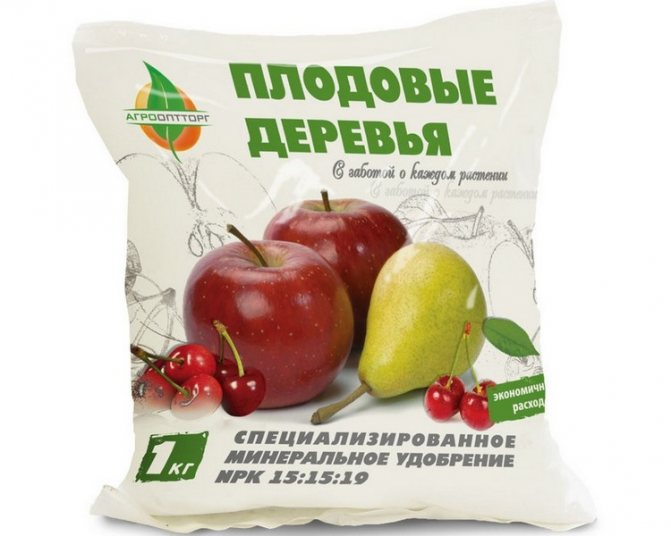

The soil requirements for the normal development of crops are as follows:
- in the place where stone fruits are planted, the soil is kept under black steam, that is, flowers, vegetables or herbs are not planted in the aisle;
- the composition of the soil must be alkaline, for this purpose it is useful to add ash, as well as lime;
- on fertile soils, trees develop quickly and bear fruit well, therefore their composition is of great importance for the cultivation of a garden;
- to determine the alkaline or acidic composition of the soil in which the plums are planted, use litmus probes (the paper is immersed in a container with a 1/1 mixture of soil and water).
Only after recognizing the composition of the soil by the color of the litmus, they determine how to feed the plums and cherries in the fall. The red color of the probe indicates that the soil is acidic, pink indicates moderate acidity, and blue indicates that it is neutral.
Typical mistakes
Many gardeners do not water their cherries in the fall, believing that this is not necessary. In fact, the plant needs frequent watering at this time, especially for young seedlings. Mature fruit-bearing trees are allowed to water less often, but more abundantly. After applying top dressing and digging the periosteal circle, the tree is watered for the last time. Then there is a slowdown in sap flow and the tree falls into a state of dormancy.
Do not prune by simply shortening the branches. It is recommended to make slices, observing an angle of 40 degrees. In young seedlings, the top is necessarily shortened.
With the onset of autumn, one should not forget about weeding in the peri-stem circle.It is also imperative to carry out a digging so that the quality of the next year's harvest does not suffer.
What organic fertilizers are used for cherries
September is the best time to refuel the soil under the cherries with organic matter. During the winter, soil bacteria will have time to process a significant part of the applied top dressing, and already in early spring, the roots of trees will be able to receive nutrients for the resumption of vegetation. Fertilizers are used under the cherries that are easier to get in a particular region.
- Compost. A similar substrate is made independently in compost pits or containers. Wait until the mass becomes uniformly black, mixed with peat for alkaline soils or with wood ash for acidic soils. Add about 2-3 buckets under each cherry, scattering evenly under the crown.
- Manure. Convenient if you have cattle breeding or stables near the garden. Fresh manure is stored in heaps and kept for about a year so that it is quail. During this time, weed seeds die in it and the chemical composition is optimized. The application rate is the same as for compost. Pig manure is not used for cherries.
- Bird droppings. If there is a chicken coop, it is harvested throughout the year and dried. Given the high concentration of nitrogen in it, the droppings are diluted in lukewarm water in a ratio of 1: 10. The trunks of cherries are spilled with this fertilizer at the rate of a bucket per tree.
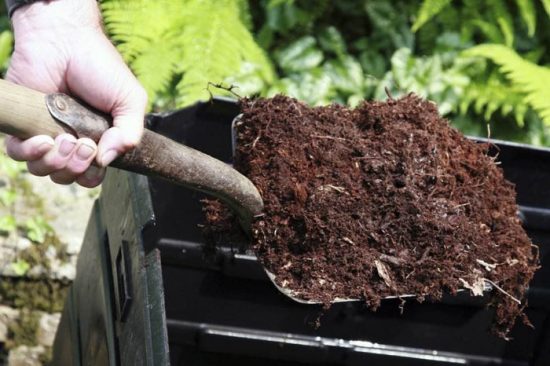

In some cases, it is advisable to add vermicompost, peat or sapropel under the cherries. The choice of fertilizer depends on the proximity of the garden to lakes, drained swamps, industrial enterprises specializing in the production of organic fertilizers.
Advice. When feeding cherries with organic matter, there is a danger of introducing nematodes into the soil. As a biological method of combating these parasitic worms in the aisles of the garden, it is recommended to sow medicinal calendula.
Removing overgrowth
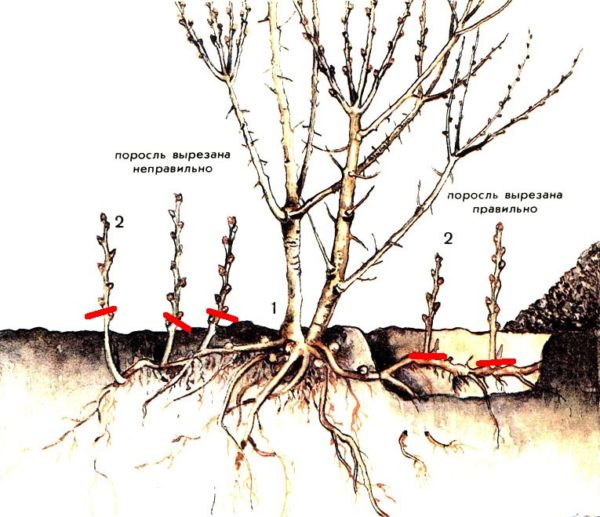

When maintenance work is not carried out at all or is performed irregularly, many small cherry growths form in the vicinity of the mother plant. It draws nutrients from the soil and root system of the plant for its development. This leads to a decrease in yield and deteriorates the quality of the berries. Therefore, young shoots are uprooted.
The only effective method to get rid of the overgrowth is to remove it manually:
- Shoots are uprooted as soon as they appear on the surface.
- Shallow holes are made around the roots of the mother plant and the shoots emanating from them are chopped off.
- The resulting wounds are poured with garden varnish.
A sharp knife is used to cut the shoots. At the same time, after removing the growth, there should be no hemp, since new branches grow out of them very quickly.
Closing events


To protect the bark from sunburn, cherry trunks are wrapped
To protect the bark from sunburn next spring, the trunks wrapped in breathable materials: white paper, non-woven fabric or whitewash with a solution of lime, to which glue or flour paste is added for strength.
To prepare the solution, take slaked lime 2 kg per bucket of water and add clays 3 kg and mullein 0.5 kg. The solution is filtered and the wood is whitened from all sides, especially carefully - from the south side.
If you follow all of the above measures, you will be able to prepare the cherries well for the winter period, and she will thank you for the next year with a bountiful harvest.
Record How to feed cherries in autumn to have a good harvest first appeared About the farm.
Eradicating autumn spraying of cherries from diseases and pests
The purpose of this autumn processing of cherries is get rid of all remaining pathogenic fungi and insect pests (including their eggs) so that they could not overwinter on / in the bark and near-trunk circle (in the soil).
Advice! The site has a separate detailed article on when and how to properly carry out the autumn eradicating spraying of the garden from diseases and pests.
As for the timing of the autumn eradication spraying, here some of the gardeners are convinced that it is better to carry out treatment against pests and diseases after leaf fall, when the tree goes into a state of dormancy, its buds will completely "close" and become inaccessible to the ingress of powerful and strong solutions, which we will spray the tree. Others believe that it will be even more effective to process trees just before leaf fall (2-3 weeks before), i.e. even on the leaves, but always after fruiting and harvesting. In this case, the leaves will quickly turn black and “burn”, but do not be afraid: this is how it should be. Due to this (loss of leaves), the tree will begin to prepare more actively for winter.
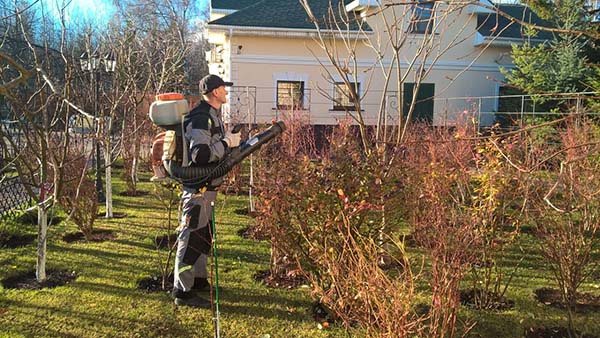

However, it is also not worth delaying too much: it is important be in time before the onset of stable frosts, otherwise the preparations (fungicides and insecticides) will simply not work and the procedure will become meaningless (as a rule, most agents are effective at temperatures up to +5).
As a means for the autumn processing of trees, iron sulfate is most often used in combination with urea or Bordeaux liquid.
Advice! The site already has detailed material about when and how to treat fruit trees and shrubs in the fall from diseases and pests.
Video: autumn eradication spraying
By the way! If in the summer you noticed that the leaves and fruits on your cherries have dried up, they are hanging as if "burned", then just know: this monilial burn (moniliosis)which affects both pome and stone fruit trees.
Autumn processing also helps from the disease. bordeaux liquid or simply copper sulfate (but they are better in the spring).


Video: how to spray cherries in autumn from moniliosis
Note! If you carried out the autumn spraying of cherries from diseases and pests, this does not mean that spray in early spring you don't need it anymore. Still as it should be! Autumn eradication spraying actually similar to early spring garden processing (the very first, it is also called eradicating).
Mineral fertilizing of cherries
In autumn, it is convenient to carry out a whole range of measures for the care of cherry plantations, including:
- loosening of near-trunk circles;
- abundant watering;
- introduction of phosphorus, potassium, organic matter;
- mulching;
- control of pests and fungal diseases;
- sanitization of the trunk and branches.
The use of phosphorus and potassium in the fall is associated with low solubility and low mobility of these elements in the soil. They need time to dissolve, but even with a whole winter at their disposal, they will remain at the depth where they were introduced.


Phosphorus and potassium can be added separately by purchasing potassium sulfate, simple or double superphosphate. Most often they are mixed or potassium monophosphate is used. In order not to burn the cherry roots, fertilizers are applied on sufficiently moist soil or previously dissolved in water. The most rational is their introduction for digging with a pitchfork or in grooves along the projection of the crown.
Prophylaxis
To prevent excessive overgrowth formation, the state of the trunk circle is constantly monitored. All fallen berries and seeds are collected. Otherwise, after overwintering, they will sprout with the onset of spring. A spreading tree growing next to cherries relieves young shoots well. But in this case, the mother plant will also be deprived of light.
Read also Dracaena leaves drooped
The choice of cherry variety also influences the growth of the growth. Usually it is given by own-rooted seedlings. If cherries are grown in a seed yard, they do not form root shoots.
Shrub pruning
Of all types of pruning, shaping and sanitary cleaning of the crown is used for young seedlings.
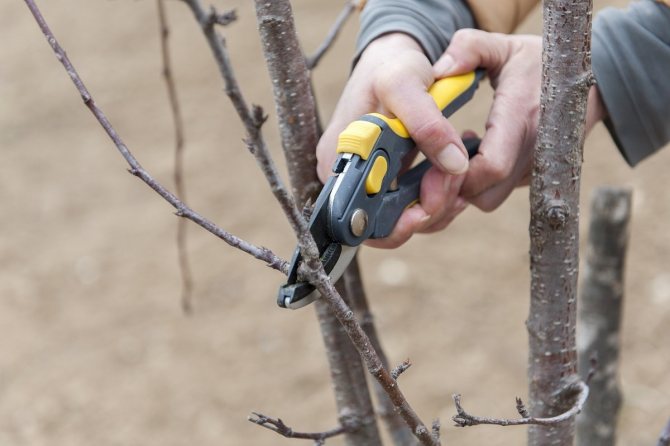

This is necessary for the tree to form skeletal branches that grow at a certain angle to the ground. If the tree begins to bear fruit, the weight of the shoot will increase significantly and the branch may crack. After planting in the spring, the first pruning is done in the fall: right after the tree has shed its leaves.
If the seedling is less than 70 cm, then pruning is carried out next spring. Usually the central shoot is shortened so that the tree grows wide. This is important for the convenience of harvesting. Cut off the shoot over 6 buds. The growth angle should be no more than 40-50 degrees in relation to the central shoot. The strongest branches are selected and left. The rest are removed or shortened.
After 2 years, 2 - 3 tiers of main branches should form on a young tree. Additional shoots are also formed on them, which are shortened. If the shoots dry out or are damaged by diseases, they are removed completely. Sections are covered with garden pitch. Pruning just before frost is not recommended, as this can lead to freezing of the shoots.
Autumn care activities
Regularly feeding cherries in summer, autumn and spring begins from the third year, when the supply of nutrients ends in the soil, and the tree begins to bear fruit, that is, take away the remnants of food from the soil.
Video: How to feed cherries in the fall
How to feed cherries depends on the availability of fertilizers. It can be organic matter - manure, compost, chicken droppings or green manure. If there are no animals and birds in the household, then gardeners use purchased mineral compositions. They also have a good effect on yield, but are not recommended for long-term use, as the soil is depleted.
The best option is a combination of organic and mineral fertilizers.
Organic matter for cherries
Organic matter is useful in that soil bacteria are needed for its decomposition. Plant and animal residues serve as food for microorganisms. In the course of their activity, substances are released into the soil, which are called humus. Humus is black in color and rich in nutrients.


It is better to apply organic matter in the fall, as it takes time for its decomposition.
How to fertilize cherries in autumn:
- rotted manure, humus or compost;
- green manure or green manure;
- bone meal or horn shavings;
- wood ash.
Fresh manure is dangerous due to the concentration of nitrogen, therefore, feeding cherries in August with fresh substance is not carried out. If there is nothing else, then proceed as follows:
- Fresh manure is poured into the bucket by 1/3 of the volume.
- Pour in water and leave for 2 weeks, stirring occasionally.
- Next, the solution is diluted: 1 liter per bucket of water.


Such a "talker" is applied after the tree goes into sleep mode and the movement of sap is suspended. In the area of the trunk circle, they dig up the soil, pour in the slurry and cover with a layer of soil. Fresh manure is preferable to use for feeding cherries in summer or spring, when the tree needs nitrogen to gain green mass or keep the foliage in good condition.
It is safer to use wood ash, since there is no nitrogen in it, and the amount of potassium, phosphorus and trace elements is very large. Plant residues in the form of ash are also insisted on water and poured into the ground under the cherries, after which they are covered with earth. It is imperative to cover the ash with soil, since soil microorganisms process organic matter in the dark. Under the influence of sunlight, they die.
The use of green manure for feeding
The cheapest fertilizer than cherries are fed in autumn is green manure.


You can sow any seeds that will grow in 1.5 months and will be ready for use as organic matter. They are cut off or left in the winter, and in the spring they dig up already decomposed remains with soil. Such feeding of cherries replaces expensive manure and well restores soil fertility.
Scheme and features of pruning ten-year-old cherries in the fall for beginners
Cherries, which are more than 5 years old, already have a formed crown. And subsequent pruning has the following goals:
- controlling the total height of the tree;
- the length of side shoots should not exceed 0.5 m.
Cutting scheme for ten-year-old cherries:
- the central conductor is cut over the weak side branch at a height of about 0.5 m;
- shoots of the third tier do less than the central conductor by 0.2 m;
- skeletal shoots should be about 0.7 - 0.8 m long.
Pruning
The rules for how to care for cherries also include pruning in the fall. Carried out in accordance with all the rules, it will not only heal the crown and increase the yield of the tree in spring, but will also become an excellent prevention against pests and the spread of diseases. Autumn pruning of apple trees, cherries and other fruit trees is considered one of the points of preparing them for winter. You need to cut off dried, broken and damaged branches and remove the damaged bark with them.


Trimming scheme
Pruning rules will be standard for all fruit trees:
- The first pruning is carried out one year after planting.
- All branches growing inward are cut off.
- Pest-damaged, broken and dried branches are removed.
- The wounds on the tree remaining after trimming are treated with garden varnish.
Pruning an old tree should be carried out in several stages; it is highly undesirable to cut too many branches from it at one time. Thus, you can extend its cultivation and yield.
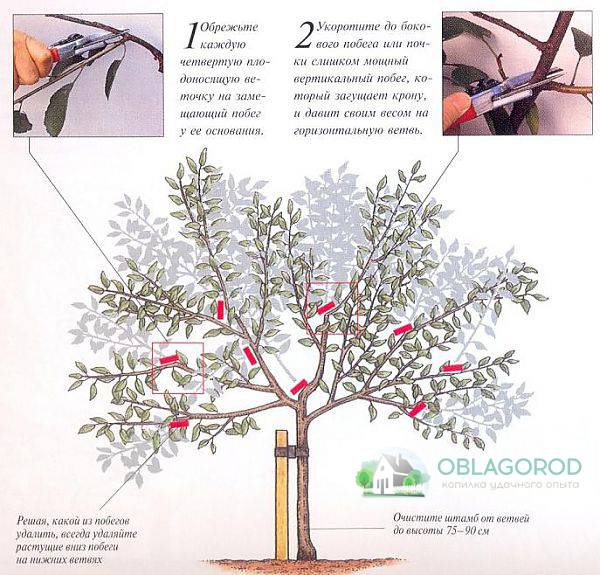

Scheme and recommendations for pruning
Such preparation of cherries for winter will allow them not only to winter normally, but also to give next year a rich harvest of berries with an impeccable, sweet and sour taste.
Organic additives
Organic matter not only enriches the fertile layer with nutrients, but also structures it well: it makes it loose and breathable. Compost and ash are used as a source of nitrogen, phosphorus and potassium.
Compost
Compost plentifully saturates the soil with nutrients. The compost heap is formed from peat, kitchen waste, chicken / cow dung. Also, the compost heap is watered with a solution of nitrate, superphosphate and urea. The compost matures for 3-4 months, and it takes up to 5 kg of the finished mass to feed a young seedling. For an adult cherry, you need 30 kg of compost mass.
Ash
Ash is a source of phosphorus and potassium, which are essential for cherries. The powder also contains other useful trace elements: zinc, iron, sulfur, calcium and magnesium. Plants are fertilized with ash throughout the growing season, and in preparation for winter, ash is an indispensable component.
Lime
Lime is necessary not only for whitewashing the trunks, but also for alkalizing the earth. Cherries do not like acidified soil, so it must be regularly deacidified with lime. Also, lime contains a sufficient percentage of calcium, which strengthens the root system and increases the immunity of plants. Dolomite has the same qualities.
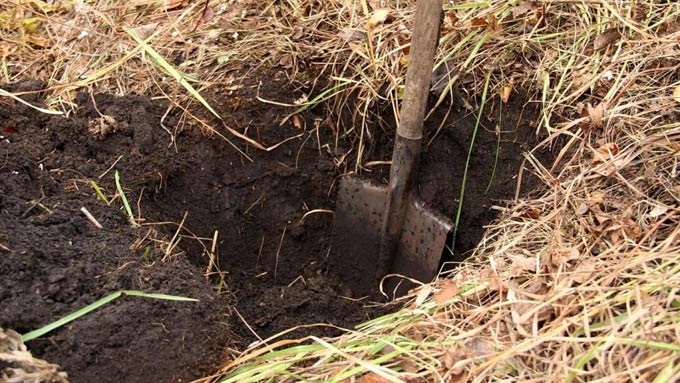

Siderata
Siderata are a quick and easy way to enrich the land with essential trace elements. To do this, plants are planted in the near-stem circle, then the stems 15 cm high are simply dropped into the ground. You can grow green manure in the garden, and then mow and bury it in a tree trunk circle. When decomposing, green manure gives the soil all the necessary substances (especially nitrogen).
How to prepare for the cold
Cherry is quite a frost-resistant plant, but still it also needs some preparation for the cold season.
In autumn, it is recommended to cover the soil near the trunk with sawdust and straw, so that the roots are not damaged by severe frost. If there are cuts left on the tree after the autumn pruning, then they must be covered with garden varnish. The trunks of young trees should be wrapped in cloth so that rodents do not damage the bark.
As you can see, even such an unpretentious plant as cherry also requires some attention and care.But, at the same time, in return you will get a good harvest of delicious and healthy berries.
Siderata under cherry
Whatever the system of soil maintenance in the aisles of the garden - steam or lawn - it makes sense in August to sow the space between the trees with mustard or a mixture of oats and peas. Mustard is considered a phytosanitary plant: its presence eliminates bacteria and fungal spores from the soil. After embedding, it quickly decays, turning into an excellent green fertilizer.
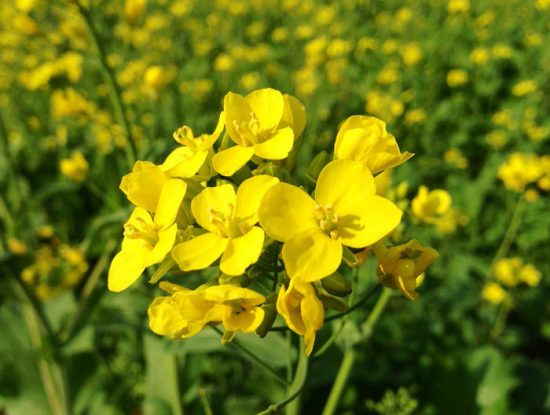

Siderat
Legumes are ideal siderates for cherries. Due to the union with nitrogen-fixing bacteria, they quickly accumulate nitrogenous substances in a form accessible to cherry trees. In addition, legumes are rich in various trace elements, without which the ripening of the crop will be difficult.
Timely and correct feeding of cherries in autumn is a guarantee of lush flowering, an abundance of bright shiny fruits and amazing jam with a signature rural sourness.


